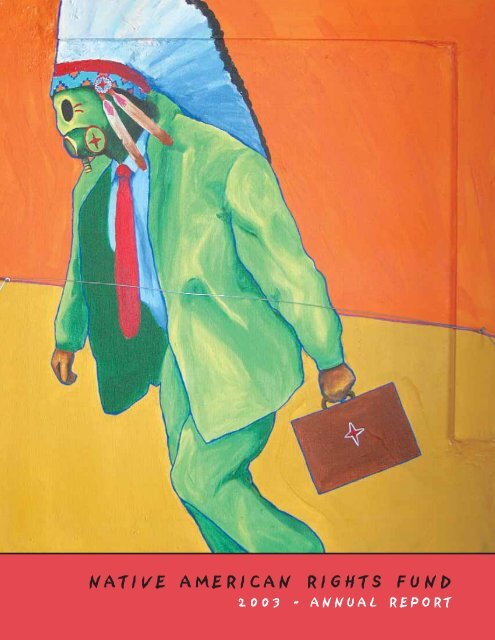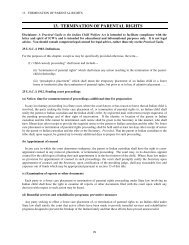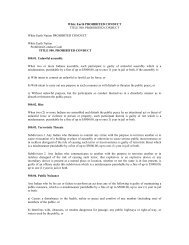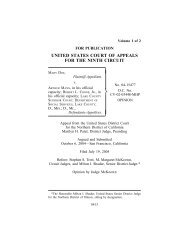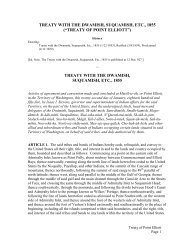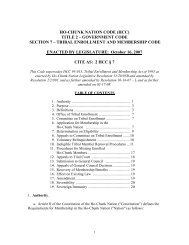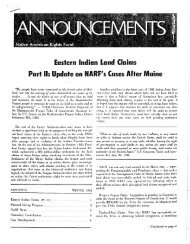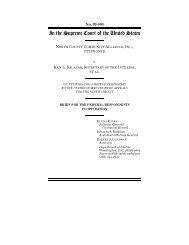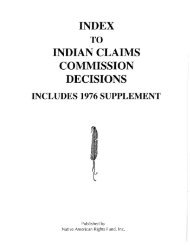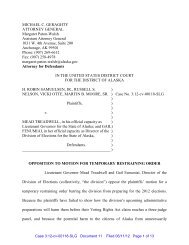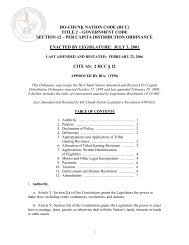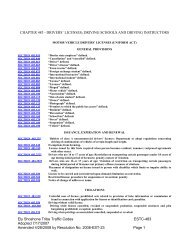2003 annual report - Native American Rights Fund
2003 annual report - Native American Rights Fund
2003 annual report - Native American Rights Fund
Create successful ePaper yourself
Turn your PDF publications into a flip-book with our unique Google optimized e-Paper software.
NATIVE AMERICAN RIGHTS FUND<strong>2003</strong> - ANNUAL REPORT
NARF - Annual Report <strong>2003</strong>Introduction ............................................................................................................................................................ 2Chairman’s Message .............................................................................................................................................. 4Executive Director’s Report ................................................................................................................................ 6The Board of Directors ........................................................................................................................................ 7The Preservation of Tribal Existence .................................................................................................................... 8The Protection of Tribal Natural Resources ...................................................................................................... 12The Promotion of Human <strong>Rights</strong> ................................................................................................................ 18Major Activities ................................................................................................................................................ 20The Accountability of Governments ............................................................................................................ 26The Development of Indian Law .................................................................................................................. 32Treasurer’s Report ............................................................................................................................................ 35Contributors ...................................................................................................................................................... 36NARF Staff ........................................................................................................................................................ 40Main Office<strong>Native</strong> <strong>American</strong> <strong>Rights</strong> <strong>Fund</strong>1506 BroadwayBoulder, CO 80302303-447-8760http://www.narf.orgAlaska Office<strong>Native</strong> <strong>American</strong> <strong>Rights</strong> <strong>Fund</strong>420 L Street, Suite 505Anchorage, Alaska 99501907-276-0680Washington, D.C. Office<strong>Native</strong> <strong>American</strong> <strong>Rights</strong> <strong>Fund</strong>1712 N Street, NWWashington, D.C. <strong>2003</strong>6202-785-4166Cover art:“Prosecution Rests”About the artist: “I believe art shouldreflect our society and the time in whichit exists. I also believe that a society’s lawsystem should have the same function.What was art 79 years ago, and what waslaw 79 years ago, do not reflect our societytoday. In the same way that the attorneysof NARF and NARF affiliates work tochange the representation of <strong>Native</strong><strong>American</strong>s within the legal system, I amworking to change the representation of<strong>Native</strong> <strong>American</strong>s in the art world.A contemporary People deserve no less thancontemporary representation.”~ Bunky Echo-HawkBunky Echo-Hawk is an enrolled memberof the Yakama Nation of WashingtonState and a member of the PawneeNation of Oklahoma. He is a graduateof the Institute of <strong>American</strong> Indian Artin Santa Fe, New Mexico. He currentlylives and paints in Longmont, Colorado.Bunky is the son of NARF attorneyWalter “Bunky” Echo-Hawk.Contact the artist:Bunky Echo-Hawk, 1212 S. Emery St. #BLongmont, CO 80501home: 303.772.8601 cell: 303.886.3859http://www.bunkyechohawk.comTax Status: The <strong>Native</strong> <strong>American</strong> <strong>Rights</strong> <strong>Fund</strong>(NARF) is a nonprofit, charitable organizationincorporated in 1971 under the laws of the Districtof Columbia. NARF is exempt from federal incometax under the provisions of Section 501(c)(3) of theInternal Revenue code. Contributions to NARF aretax deductible. The Internal Revenue Service hasruled that NARF is not a “private foundation” asdefined in Section 509(a) of the Internal RevenueCode. NARF was founded in 1970 and incorporatedin 1971 in Washington, D.C.native american rights fund - <strong>annual</strong> <strong>report</strong>1
IntroductionAs the <strong>Native</strong> <strong>American</strong><strong>Rights</strong> <strong>Fund</strong> (NARF) begins itsthirty-fourth year of legal advocacy,it is fueled by the strength of itsvaried legal accomplishments aswell as the active memory ofreasons why it was founded in thefirst place. In 1970, a small butdetermined group of attorneysand tribal leaders created the<strong>Native</strong> <strong>American</strong> <strong>Rights</strong> <strong>Fund</strong> toaddress the need for legal representationin many major issuesfacing Indian people who couldperhaps not afford it otherwise.One of the first institutions ofits kind, NARF has been anto this day and provide a constant,unending need for NARF tocontinue its fight. To guide iton this purpose, NARF’s firstBoard of Directors created fivefundamental priorities:• Preservation of tribal existence• Protection of tribal naturalresources• Promotion of <strong>Native</strong> <strong>American</strong>human rights• Accountability of governmentsto <strong>Native</strong> <strong>American</strong>s• Development of Indian law andeducating the public aboutIndian rights, laws, and issuesFoundation, the General ServiceFoundation, the John D. &Catherine T. MacArthurFoundation, the CarnegieCorporation of New York, theW. K. Kellogg Foundation andthe Skadden Foundation have alsomade consistent contributionsover the years. Federal fundingfrom the Administration for<strong>Native</strong> <strong>American</strong>s enables NARFto carry on its governance, economic,and social developmentefforts in Indian country. Finally,the effects of NARF’s work arereflective in the financial contributionsby a growing number ofunyielding advocate of <strong>Native</strong>peoples’ needs resulting fromtheir unique government-togovernmentrelationship with thefederal government and the rightsthat this sovereign status shouldconfer. NARF’s diligence andvision have resulted in a multitudeof <strong>Native</strong> <strong>American</strong> legal victoriesin areas ranging from tribalsovereignty to natural resourceownership to human rights.Despite these crucial gains, however,NARF must contend withsome of the same challenges thatoriginally propelled its formation.The historic injustices perpetratedagainst <strong>Native</strong> peoples continueAs this battle continues,NARF strives to protect the legaland sovereign rights of tribes and<strong>Native</strong> people within the<strong>American</strong> legal system. Thiseffort certainly could not existwithout the contribution of thethousands of individuals whohave offered their knowledge,courage, and vision to help guideNARF on its quest. Of equalimportance, NARF’s financialcontributors have graciously providedthe resources to make theseefforts possible. Contributorssuch as the Ford Foundationhave been with NARF since itsinception. The Rockefellertribal governments. United, thesefinancial, moral, and intellectualgifts provide the framework forNARF to fulfill its mission: thesecuring of sovereignty and rightto self-determination to whichall <strong>Native</strong> <strong>American</strong> peoplesare entitled.“ Tribal Law”native american rights fund - <strong>annual</strong> <strong>report</strong>3
Chairwoman’s MessageAloha, Aloha ke Akua, na¯‘aumakua a me na ¯ Kupuna: ¯Huliau! (Time of Change!)The <strong>Native</strong> <strong>American</strong> <strong>Rights</strong><strong>Fund</strong> (NARF) continues to be amajor influence for change. In myfour years on the NARF Board ofDirectors, I have enjoyed a muchcherished opportunity to learn fromand work with ‘ohana (family)from Turtle Island and now,as its Chairwoman, will do mybest to embrace the privilege,challenges and responsibilitiesthat come with this position.With your confidence and trust,I look forward to sharing myknowledge and experience as anadvocate for justice from ka pae‘aina ¯ o Hawai’i, the land and oceanthat feed us in the archipelago ofHawai’i. Mahalo a nui loa forthis opportunity to extend ourinfluence and commitment toaddress <strong>Native</strong> issues.As Lili’uokalani, the last rulingmonarch and queen of the Nationof Hawai’i, expressed (until illegallydethroned by “evil” descendants ofmissionaries with the backing of theUnited States military in 1893):“I could not turn backtime for the political change,but there is still time to saveour heritage. You must remembernever to cease to act becauseyou fear you may fail. The wayto lose any earthly kingdom isto be inflexible, intolerant, andprejudicial. Another way is tobe too flexible, tolerant of toomany wrongs and without judgmentat all. It is a razor’s edge.It is the width of a blade ofpili grass.”NARF has diligently workedat carrying out its mission to supportthe integrity and strength ofits peoples and cultures, providinghelp to rebuild nations and tribes,through difficult and often seeminglyinsurmountable challenges.As an organization, NARF willcontinue to develop and implementinnovative strategies thatwill effectively deal with harminflicted on native peoples. In itsthirty-four years of service, NARFhas provided invaluable legal andmoral support to “Indian Country”as its peoples struggle againstoppressive laws, practices andgovernmental systems and hasremained responsive and accountableto its constituents. NARFmust continue to take bold stepswhen necessary to ensure thatit remains a strong and viableresource for the continuing benefitof those who draw upon itsexpertise, compassion, andstrength as an organization committedto advocating for peaceand justice.NARF’s cases accentuate theburden of “Indian Country” andreveal the amazing spirit andresilience of its peoples to endureand survive severe acts of physical,economic and cultural genocide.I have experienced this sameamazing spirit at NARF and havewitnessed John Echohawkdynamically lead a brilliant anddedicated team of advocates forgeahead to defend, protect andwork to make whole <strong>Native</strong>America.Nana ¯ ¯ I Ke Kumu![Look to the Source!]A renewed respect for ourtraditional values helps us toresolve the political, economic,and social problems that impactour community. It is now morethan ever crucially important thatwe rediscover the power of traditionalteachings and apply themto contemporary problems. Byreinvigorating the principlesembedded in our ancient teachings,we honor the memory and wisdomof our ancestors. With the mana(spiritual energy and life force)of our ancestors and our ownwisdom, vitality and courage, wewill prevail and maintain thisinterdependency and enforce theintegrity of our cultures.A primary challenge this NewYear, Makahiki 2004, will be tostrengthen NARF’s financialresources. Our Board is streamliningexisting financial commitmentsand implementing more efficientinvestment and self-sustainingstrategies. With your kokua ¯ andkako’o, ¯ your help and continuingsupport, we will have the financialstrength to continue to focus onissues of concern to the peoplesof “Indian Country,” and resolveinjustices that support the legalrights of <strong>Native</strong> nations, peoplesand communities. We encouragethose Nations that are doing welleconomically to show their supportfor NARF with financial contributionsto help it to continue itsimportant and necessary work tobring justice and peace to <strong>Native</strong>communities.Our communities‚ healthand well-being are of utmostimportance to preserve ourtraditional values because it givesus the necessary strength for ournations’ survival and growth inthis rapidly changing world. Wemust be extra vigilant not tounconsciously participate in ourown exploitation by turning awayfrom the voice of our ancestors inorder to pander to mainstreamsociety. In working to achieveeconomic independence andsocial justice, we exercise ourindependence of mind and spiritto defend our lands and rights.We must continue to take ourrightful place in the world andnot depend upon others to securethe revitalization of our cultures.Our ancestor, Kapihe, shared thispromising prophecy with us:E iho ana o luna;That which is above shall bebrought down;E pi’i ana o lalo;That which is below shall be lifted;E hui ana na ¯ moku;The islands shall be united;E ku ¯ ana ka paia.;The walls shall stand upright.I would like to share theserevealing words from QueenLili’uokalani of the Nation ofHawai’i: “Oh, honest <strong>American</strong>s,as Christians hear me for my downtroddenpeople! Their form ofgovernment is as dear to them asyours is precious to you. Quite aswarmly as you love your country, sothey love theirs. …to hear what isnot said, to see what cannot be seen,and to know the unknowable, thatis Aloha.”And finally, in the words ofour most respected 19th CenturyFreedom advocate, JosephNawahi: “The cause of Hawaii andindependence is larger and dearerthan the life of any man connectedwith it. Love of country is deepseatedin the breast of everyHawaiian, whatever his station.”We are at a turning point,Huliau, a moment of truth. Letus holomua kakou (move forwardtogether) in 2004 ¯ with the greatspirits of Turtle Island, the alohaspirit of Hawai’i, and with themana of natives throughout theworld. May all people on thisearth enjoy peace, justice andaloha.Ku’e! ¯ Ku’e! ¯ Ku’e! ¯(Resist! Resist! Resist!)Holomua! (Move Forward!)Ea! (Life!)E. A. Ho`oipo Kalaena’auao Pa,Chairwoman4 <strong>annual</strong> <strong>report</strong> - native american rights fundnative american rights fund - <strong>annual</strong> <strong>report</strong>5
Executive Director’s ReportThe Board of Director’sThe <strong>Native</strong> <strong>American</strong> <strong>Rights</strong><strong>Fund</strong>’s program of providing legaladvice and assistance to <strong>Native</strong><strong>American</strong>s across the country onlegal issues of national significancecontinued into its 33rd year infiscal year <strong>2003</strong>. Substantialdevelopments and importantvictories were achieved in severalcases and activities during theyear that I want to highlight.In United States v. WhiteMountain Apache Tribe, theUnited States Supreme Courtheld that the United States’breach of fiduciary duty tomaintain and preserve Indiantrust property gave rise a claim formoney damages under federal law.Through the Tribal SupremeCourt Project operated by NARFand the National Congress of<strong>American</strong> Indians, amicus briefswere coordinated and filed insupport of the White MountainApache Tribe in this importantfederal trust responsibility case.Once again, NARF assistedthe Gwich’in Steering Committeein their efforts to protect theArctic National Wildlife Refuge(ANWR) in Alaska from oildevelopment and successfullyworked with a coalition ofenvironmental groups to stopthe U.S. Senate in <strong>2003</strong> fromapproving oil drilling in ANWR.7,000 Gwich’in people live on ornear the migratory route of thePorcupine caribou herd and relyon the caribou for food, clothing,tools and a source of respect andspiritual guidance. The calvinggrounds of the caribou lie insideANWR and will be disturbed byany oil drilling.Representing several Alaskatribes and tribal members,NARF successfully intervened ina case brought by a sporting clubchallenging federal regulationsimplementing the preferencecontained in federal law forcustomary and traditional uses offish and wildlife by rural Alaskansover sports and commercial useson federal public lands in Alaska.NARF will help defend over 180customary and traditional usedeterminations made by thefederal government which protectthe entitlement of rural areas orcommunities to take fish andwildlife and limit or prohibitothers from taking the resource.With the support and encouragementof the U.S. Departmentof Education, NARF helped toestablish the Tribal EducationDepartments National Assembly(TEDNA), a new nationalorganization for tribal educationdepartments. The purpose of theTEDNA is to bring together tribaleducation directors, staff and policymakers so that they can shareinformation, strategize andproblem solve on common issuesof education governance, policyand advocacy at the tribal,regional and national levels.In a widely publicized case,NARF and private co-counselwon another important decisionin Cobell v. Norton, the classaction on behalf of 300,000 individualIndian trust account holderswhich was filed in 1996. FederalDistrict Court Judge RoyceLamberth issued a structuralinjunction requiring theDepartment of the Interior toconduct a historical accounting ofthe trust accounts going back totheir origin in 1887. In addition,the Cobell plaintiffs also agreed toseek a mediated solution to thecase as proposed by Congress.NARF also assisted in obtaininga $2 million appropriation toimplement the Indian TribalJustice and Legal Assistance Act,which we helped to pass inCongress in 2000. The Actauthorizes the Justice Departmentto provide supplemental fundingto Indian legal services programsfor their representation of Indianpeople and tribes which fall belowthe federal poverty guidelines.The <strong>Native</strong> <strong>American</strong> <strong>Rights</strong><strong>Fund</strong> thanks all of our contributorsand supporters who have helpedto make these victories and developmentsfor <strong>Native</strong> <strong>American</strong>spossible. As we face projectedfunding deficits in the future,your continuing support is moreimportant now than ever beforeif we are going to maintain ourefforts to seek justice for <strong>Native</strong><strong>American</strong>s through the legal system.John E. Echohawk,Executive DirectorThe <strong>Native</strong> <strong>American</strong> <strong>Rights</strong><strong>Fund</strong> has a governing board composedof <strong>Native</strong> <strong>American</strong> leadersfrom across the country – wiseand distinguished people who arerespected by <strong>Native</strong> <strong>American</strong>snationwide. Individual Boardmembers are chosen based ontheir involvement and knowledgeof Indian issues and affairs, as wellas their tribal affiliation, to ensurea comprehensive geographicalrepresentation. The NARF Boardof Directors, whose membersserve a maximum of six years,provide NARF with leadershipand credibility, and the vision ofits members is essential to NARF’seffectiveness in representing its<strong>Native</strong> <strong>American</strong> clients.The National Support Committee(NSC) assists NARF with itsfund raising and public relationsefforts nationwide. Some of theindividuals on the Committee areprominent in the field of business,entertainment and the arts. Othersare known advocates for the rightsof the underserved. All of the 48volunteers on the Committee arecommitted to upholding therights of <strong>Native</strong> <strong>American</strong>s.NARF’s Board of Directors:(Pictured from left clockwise) Vernita Herdman (Inupiaq - Alaska); Nora McDowell(Fort Mojave - California); John Gonzales (San Ildefonso Pueblo - New Mexico);Paul Ninham (Oneida Nation of Wisconsin); Jaime Barrientoz, Vice-Chairman(Grande Traverse Band of Ottawa & Chippewa Indians - Michigan); James Roan Gray(Osage Nation - Oklahoma); E. Ho’oipo Pa, Chairwoman (<strong>Native</strong> Hawaiian - Hawaii).(Not Pictured) Mark Brown (The Mohegan Tribe - Connecticut); Elbridge Coochise(Hopi - Arizona); Billy Frank (Nisqually Tribe - Washington); Karlene Hunter (OglalaLakota - South Dakota); Anthony Pico (Viejas Band of Kumeyaay Indians - California);Woody Widmark (Sitka Tribe - Alaska).Owanah Anderson, ChoctawEdward AsnerKatrina McCormick BarnesDavid BrubeckU.S. Senator Ben Nighthorse Campbell,Northern CheyenneWallace Coffey, ComancheAda Deer, MenomineeHarvey A. DennenbergMichael J. DriverRichard DysartLucille A. Echohawk, PawneeLouise Erdrich, Turtle Mountain ChippewaJames GarnerSy GombergCarol Hayward, Fond Du Lac ChippewaRichard Hayward, Mashantucket PequotJohn HellerEmilie Heller-RhysAlvin M. Josephy, Jr.Charles R. KlewinNancy A. KlewinWilma Mankiller, Cherokee Nation ofOklahomaChris E. McNeil Jr., Tlingit-Nisga’aBilly Mills, Oglala SiouxN. Scott Momaday, KiowaClinton Pattea, Ft. McDowell YavapaiAmado Peña Jr., Yaqui/ChicanoDavid Risling Jr., HoopaPernell RobertsWalter S. Rosenberry, IIIMarc & Pam RudickLeslie Marmon Silko, Laguna PuebloConnie StevensErnie Stevens, Jr., Wisconsin OneidaAnthony L. Strong, Tlingit-KlukwanMaria Tallchief, OsageAndrew Teller, Isleta PuebloVerna Teller, Isleta PuebloStuds TerkelTenaya Torres, Chiricahua ApacheRichard Trudell, Santee SiouxRebecca Tsosie, Pascua YaquiThomas TureenAine UngarRt. Rev. William C. Wantland, SeminoleDennis WeaverW. Richard West Jr., Southern CheyenneMary Wynne, Rosebud Sioux6 <strong>annual</strong> <strong>report</strong> - native american rights fundnative american rights fund - <strong>annual</strong> <strong>report</strong>7
The Preservation of Tribal ExistenceNARF works to construct thefoundations that are necessary toempower tribes so that they cancontinue to live according totheir <strong>Native</strong> traditions, to enforcetheir treaty rights, to insure theirindependence on reservationsand to protect their sovereignty.Specifically, NARF’s legal representationcenters on sovereigntyand jurisdiction issues, federalrecognition and restoration oftribal status, and economic development.Thus, the focus ofNARF’s work involves issuesrelating to the preservation andenforcement of the status of tribesas sovereign governments. Tribalgovernments possess the power toregulate the internal affairs oftheir members as well as otheractivities within their reservations.nation-wide Indian amicus briefwriting network. An amicusbrief, also known as a ‘friend ofthe Court’ brief, allows those notdirectly involved in litigation, butpotentially impacted by the outcome,to raise points before theCourt. Through amicus briefwriting and coordination, NARFassists Indian country as a wholein most effectively supporting thetribes going before the Court.The Project submits to the Courtthe fewest number and highestquality briefs in support of theIndian argument. This coordinatedapproach ensures that the briefsand the Indian voice get theCourt’s maximum attention.The Project submitted amicusbriefs in the three cases decided in<strong>2003</strong>, United States v. WhiteJurisdictional conflicts often arisewith states, the federal government,and others over tribal sovereignty.TRIBAL SOVEREIGNTYSecuring and developing tribalgovernmental authority derivedfrom tribal sovereign status is apriority issue for NARF becauseof its importance in maintainingtribal existence and self-government.As part of this commitment totribal sovereignty, NARF hasjoined forces with the NationalCongress of <strong>American</strong> Indians(NCAI) to create the TribalSupreme Court Project.The Tribal Supreme CourtProject is a project to coordinateand strengthen the advocacy oftribal sovereignty and otherIndian issues before the SupremeCourt, and ultimately to improvethe deplorable win-loss recordtribes have suffered before thattribunal. In fact, over the pasttwenty years, Indian people havelost approximately 80% of theircases before the Supreme Court.As one Indian law scholar hasnoted, no other group of litigantshas done worse. The opinions aredeparting from longstanding,established principles of Indianlaw and are constituting a wholesalere-writing of the very conceptionsof tribal sovereignty andjurisdiction by the Court. Thesecases have diminished the rightsof every Indian tribe in the country.The Supreme Court Project is away for tribes to take action toprevent further erosion.In recognition of the fact thatthe tribes generally rise and falltogether in front of the Court,NARF coordinates, and substantivelycontributes to, the Project’sMountain Apache Tribe, UnitedStates v. Navajo Nation, and InyoCounty v. Paiute-Shoshone Indiansof the Bishop Community, casesraising fundamental issues of tribalsovereignty. Perhaps because ofthe Project’s involvement, onlyone of these cases was lost. Victorywas achieved in one case and theother was remanded to the lowercourt for further proceedings.In United States v. WhiteMountain Apache Tribe, the Court“Alpha Scout”native american rights fund - <strong>annual</strong> <strong>report</strong>9
uled in favor of the Tribe holdingthat the United States’ breach offiduciary duty to maintain andpreserve Indian trust propertygave rise to a claim for moneydamages under federal law. InUnited States v. Navajo Nation,the Court ruled against the Tribeholding that the Tribe’s claim forcompensation did not derive fromany liability-imposing provisionof Indian Mineral Leasing Act orits implementing regulations. InInyo County v. Paiute-ShoshoneIndians of the Bishop Community,the Court vacated the UnitedStates Court of Appeals for theNinth Circuit favorable opinionon tribal immunity from suit andremanded the case back to theNinth Circuit on jurisdictionalgrounds.In the 1950s, Congressionalexperiments with terminating thefederally recognized status of<strong>Native</strong> <strong>American</strong> tribes and forcingtheir assimilation under state lawproved to be a disaster, compellingCongress decades later to restorethe tribal status of terminatedtribes. In turning the page backto the 1950s, the AlaskaLegislature has for several yearsengaged in litigation against theDepartment of the Interior andAlaska Tribes to terminate thefederally recognized tribal statusof Alaska Tribes. The AlaskaLegislature’s efforts have beenactively supported by AlaskaSenator Ted Stevens, who hasdirectly urged Interior SecretaryGale Norton to reverse theDepartment’s recognition ofAlaska Tribes. Pending the outcomeof this litigation, SenatorStevens has commenced a newcampaign to defund Alaska <strong>Native</strong>Tribes in various spending bills.The effect of these and similarmeasures, if enacted, would be toslowly cut off the ability of Alaska<strong>Native</strong> Tribes to function bydenying them the ability to providefor the health, safety and welfareof their communities. SenatorStevens, in remarks to the pressmade in October <strong>2003</strong>, madeclear that his opposition to Alaskantribes is not about funding multipletribal governments, but aboutterminating altogether the sovereigntyof Alaska tribes. If SenatorStevens’ proposals become policy,such action would deteriorate thesovereign rights of all tribes, woulddenigrate the fundamental importanceof federal recognition, andset a dangerous precedent thatwould reflect a new Congressionalpolicy of acquiescing to the whimsof congressional members whofavor the termination of federallyrecognized tribes.NARF is leading efforts togive voice to tribal governmentsin Alaska by organizing a nationalcampaign to alert tribal leaders ofthe pending threat. Efforts areunder way to conduct hearingsthroughout rural Alaska to receivetestimony from tribal governmentson issues of self-governance andthe delivery of government servicesto tribal members. The testimonyand data from these hearing willbe compiled into a <strong>report</strong> thatcan be delivered to Congress andused as a basis for rebuttingSenator Stevens’ rhetoric thatgovernment and services are bestadministered by state entities.In the case of Runyon v.AVCP, NARF prepared an amicusbrief on behalf of the AlaskaInter-Tribal Council (AI-TC) thatwas filed with the Alaska SupremeCourt in April <strong>2003</strong> in a case thatraises the question of whetherthe Alaska Village Council ofPresidents (AVCP), a tribal consortiumorganized as a non-profitunder the laws of Alaska, can raisederivative sovereign immunity asa defense to suit. AI-TC’s amicibrief does not take a position withregard to whether AVCP possessesderivative sovereign immunity;rather, it rebuts the argumentsraised by amici for the plaintiffs,the Alaska Legislative Council,who urged the Court to reconsiderits historic holding in John v.Baker in 1999 that tribes inAlaska have been federally recognized.Oral argument was heardin September <strong>2003</strong> and a decisionis pending.FEDERAL RECOGNITIONOF TRIBAL STATUSAchieving legal status as anIndian tribe is very important topreserving tribal existence andself-government. Some tribalgroups do not have this statusbecause they have never beenformally recognized as tribes bythe federal government. NARFprovides representation to thosetribal groups who have a rightto become federally recognizedtribes.NARF currently representsfive Indian communities whohave survived intact as identifiableIndian tribes but who are notfederally recognized. These Indiantribes, for differing reasons, donot have a government-to-governmentrelationship between themselvesand the federal government.Traditionally, federal recognitionwas accorded to a tribe throughtreaty, land set aside for a tribe, orby legislative means. The majorityof these NARF clients are seekingan administrative determinationby the Bureau of Indian Affairs(BIA) that they, in fact, havecontinued to exist as Indian tribesfrom the time of significant whitecontact to the present day andhave continued to govern themselvesand their members. NARF,therefore, prepares the necessaryhistorical, legal, and anthropologicaldocumentation to supporta petition for acknowledgment.For more than 100 years, theseIndian communities have beendenied the benefits of a formalrelationship with the federalgovernment. Through the processof administrative acknowledgment,NARF is now trying to bridgethat gap.Federal recognition is anarduous process that takes manyyears to complete. Petitioningtribes must prove that they havebeen identified by reliable externalsources on a substantially continuousbasis as an Indian entity;they must prove that they havemaintained a continuous communityfrom historical times to thepresent day; they must show thatthey have maintained politicalauthority or influence on a substantiallycontinuous basis fromhistorical times until the presentday; they must prove that currenttribal members, as a whole,descend from a historic tribe ortribes which amalgamated; theymust prove that their membersare not mostly members of analready recognized tribe; and,their members cannot be fromgroups which were terminated bylegislation. This process requiresthe testimony of many expertsand thorough documentation ofeach requirement.In 1997, the Branch ofAcknowledgment and Research(BAR) placed the Little ShellTribe of Chippewa Indians ofMontana’s federal recognitionpetition on active review status.In 2000, after many delays, theAssistant Secretary published apreliminary finding in favor ofrecognition. Work continues tobe done to strengthen the Tribe’spetition and the period forsupplementing the record hasbeen extended to January 2004,because of a large amount of newdata being collected and analyzed.NARF and the Tribe are nowexploring legislative options theTribe may have for recognition.With NARF’s assistance, theShinnecock Indian Nation locatedon Long Island, New York, filed apetition for Federal recognition in1998. In response, the Bureau ofIndian Affairs (BIA) sent a letterof technical assistance to theNation that pointed out allegedomissions or deficiencies in thepetition. Pursuant to the Federalacknowledgment regulations, theNation filed a response to the letterin March <strong>2003</strong>. The petition willnow be placed on the BIA’s readyfor-active-considerationlist whichis a first-come, first-served list.The list is a procedural stepprior to being placed on ActiveConsideration when at such timethe petition will be activelyreviewed by the BIA research staffthat conducts such reviews.On behalf of the UnitedHouma Nation of Louisiana,NARF responded to proposedfindings against federal acknowledgmentissued by the BIA undertheir acknowledgment regulations.The Tribe has their petitionfor federal recognition pendingbefore the BIA’s Branch ofAcknowledgment and Researchand is now waiting for a finaldecision on its petition. NARFhas also filed a petition for federalrecognition for the MashpeeWampanoag Tribe of Massachusettsthat is now under active considerationby the BIA. Work on apetition for the Pamunkey Tribein Virginia continues.10 <strong>annual</strong> <strong>report</strong> - native american rights fundnative american rights fund - <strong>annual</strong> <strong>report</strong>11
The Protection of Tribal Natural ResourcesThrough the process ofEuropean conquest and colonization,Indian tribes experienced asteady diminishment of their landbase to a mere 2.3 percent of itsoriginal size. Currently, there areapproximately 55 million acres ofIndian-controlled land in thecontinental United States andabout 44 million acres in Alaskawhich are owned by <strong>Native</strong>s afterthe 1971 Alaska <strong>Native</strong> ClaimsSettlement Act. Central to maintainingeconomic self-sufficiencyas well as genuine self-determination,the possession of an adequateland base and resources are vitalto the existence of tribes. Withoutsuch fundamental necessities,tribal life is virtually impossibleto maintain. NARF’s work toensure tribal control over theirland, water, and subsistence rightsholds importance beyond materialwealth; indeed, it safeguards thevery core of tribal existence.The federal government hasin many instances failed to fulfillits trust duty to protect Indiantribes and their property rights.The <strong>Native</strong> <strong>American</strong> <strong>Rights</strong><strong>Fund</strong> concentrates much of itslegal representation on cases thatwill ensure a sufficient naturalresource base for tribes.PROTECTION OF INDIANLANDSThe Alabama-Coushatta Tribeof Texas seeks compensation forthe loss of use of millions of acresof fertile forest that they onceoccupied in southeast Texas. TheTribe has been represented byNARF since 1981 in their questto prove that their ancestral landwas illegally taken from them bysettlers. In 1996, the UnitedStates Court of Federal Claimsruled in Alabama-Coushatta Tribeof Texas v. United States that theUnited States should compensatethe Alabama-Coushatta Tribe forthe loss of use of ancestral landillegally taken without federalapproval between 1845 and 1954.In 2000, the United States Courtof Federal Claims ruled onceagain in favor of the Alabama-Coushatta Tribe of Eastern Texasin their breach-of-trust claimagainst the United States, holdingthe Government liable for theTribe’s loss of use of over 2.85million acres of land between1845 and 1954. The court alsoruled that 5.5 million acres ofaboriginal title has never beenextinguished, so the Tribe alsohas a possessory land claimagainst the current occupants of5.5 million acres. Negotiators forthe U.S. and Tribe reached anagreement on the amount ofdamages, $270 million, and theCourt submitted a favorablerecommendation to Congress in2002 on the Tribe’s breach oftrust claim against the UnitedStates. NARF and the Tribeare now working to garnerCongressional approval for thepayment of this amount underthe Congressional referenceprocedure.NARF represents theKeewattinosagaing or NorthernLakes Potawatomi Nation ofCanada, a band of Pottawatomiesdescended from the historicPotawatomi Nation, which from1795 to 1833 signed a series oftreaties with the United States.These treaties provided, amongother things, the payment ofcertain annuities. The ancestorsof the present-day CanadianPotawatomi fled to Canadafollowing the signing of the finaltreaty, the Treaty of Chicago in1833, because they did not wantto be moved west of theMississippi. They were neverpaid their annuities. In 1993,NARF brought suit on behalf ofthe Tribe in the Court of FederalClaims, by way of Congressionalreference, to seek redress of thesefailed payments. After years offact-finding, discovery and briefingof this case, the Tribe and theUnited States agreed in principleto the settlement of this case.Settlement terms were approvedby the Court in 2000 and settlementlegislation was presented toCongress in 2001, 2002, and<strong>2003</strong> for compensation of $1.83million. Congress has yet toapprove the settlement legislation.NARF is working with theLower Brule Sioux Tribe againstthe State of South Dakota’schallenge to the United States’decision to place approximately91 acres of land into trust for theLower Brule Sioux Tribe underSection 465 of the IndianReorganization Act. The State isalleging, among other things, thatthe Secretary lacks authority toplace land into trust becauseSection 465 is an unconstitutionaldelegation of legislative authority.In an earlier proceeding regardingthis same 91 acres of land, theEighth Circuit Court of Appealsdid hold that Section 465 wasunconstitutional but the SupremeCourt vacated that opinion andremanded to the Secretary forfurther reconsideration. The Stateis now challenging the Secretary’sreconsidered, and again favorable,decision to place the land in trust.The Tribe filed a motion to intervenein this case, but the federaldistrict court denied the Tribe’smotion. The Tribe appealed tothe Eighth Circuit on the issueof the Tribe’s intervention. TheEighth Circuit upheld the districtcourt’s denial of the Tribe’smotion for intervention in March<strong>2003</strong>. The Tribe will not beallowed to participate in thelitigation as a party, but will haveits interests represented by theUnited States.In 2002, the Secretary of theInterior invited the Klamath Tribesto meet with the Presidentiallyappointed Klamath River BasinFederal Working Group (WorkingGroup) chaired by SecretaryNorton, and including theSecretaries of Agriculture andCommerce, and the Chairman ofthe Council on EnvironmentalQuality. These appointments“De Soto’s Legacy”offer an unprecedented opportunityto restore the land, water, hunting,fishing and gathering resources ofthe Klamath Tribes. Discussionsare now taking place betweentribal representatives, assisted byNARF, and the Secretary’s designatedteam to seek long termsolutions to an entire range ofwater, land, and wildlife issuesfacing the people of the KlamathBasin in Oregon and California.This historic and broad invitationexpressly included the possiblereturn of lands taken from theTribes in the 1960s under the12 <strong>annual</strong> <strong>report</strong> - native american rights fundnative american rights fund - <strong>annual</strong> <strong>report</strong>13
now repudiated “Termination”policy. Discussions also includethe restoration of degraded fishand wildlife habitat that currentlyprevent tribal resources fromproviding subsistence for tribalmembers.NARF represents the <strong>Native</strong>Village of Tuluksak in Alaska intheir quest to have the landowned by the Village corporationtransferred over in fee simple tothe Village tribal council. TheDepartment of Interior wouldthen be petitioned to place theland into trust on behalf of theVillage. The Department of theInterior is in the process of revisingregulations governing the processof taking land into federal trustfor <strong>Native</strong> <strong>American</strong>s. NARFworked with the NCAI TribalLeaders’ Task Force on LandRecovery, on behalf of Tuluksak,to develop comments to the proposedregulations and has beenwaiting for the Secretary of theInterior to issue final regulations.The Department of the Interiorhas decided to further postponeconsideration of a new regulation,after an assessment of ongoingpolicy work, available personneland resources. The <strong>Native</strong> Villageof Tuluksak is weighing whetherto move forward with litigation atthe current time.NARF has played a key rolein the implementation of federalenvironmental law and policythat recognizes tribal governmentsas the primary regulators andenforcers of the federal environmentallaws on Indian lands.NARF continued to work withtribes, the National TribalEnvironmental Council and otherIndian organizations to maintainthe progress that has been madewith the EnvironmentalProtection Agency (EPA) andother federal agencies. With arepresentative on the GreenGroup, a coalition of nationalenvironmental leaders, NARFcontinues to coordinate withand educate the environmentalcommunity on the role of tribalgovernments in environmentallaw and policy.NARF assists the Gwich’inSteering Committee in theirefforts to protect the ArcticNational Wildlife Refuge(ANWR) from oil development.The Gwich’in, which means‘People of the Caribou’, are thenorthernmost Indian nation livingacross northeast Alaska andnorthwest Canada. There areabout 7,000 Gwich’in people wholive on or near the migratoryroute of the Porcupine CaribouHerd. For thousands of years,the Gwich’in have relied on thecaribou for food, clothing, tools,and a source of respect andspiritual guidance. The calvinggrounds of the Porcupine Rivercaribou herd inside ANWR isconsidered sacred. The Gwich’incall it “Vadzaih googii vi dehk’itgwanlii” (The Sacred Place WhereLife Begins). The Gwich’in willnot journey into these sacredgrounds for hunting, even intimes of great need or food shortage.Oil development in ANWRwould not only harm the caribouand threaten the future of theGwich’in people, but would alsothreaten more than 180 species ofbirds, and numerous mammalsincluding polar bears, musk ox,wolves, wolverine, moose, Arcticand red foxes, black bears, brownbears, and the white Dall sheep.NARF successfully worked with acoalition of environmental groupsand organizations to stop the U.S.Senate from approving oil drillingin ANWR in 2001 and 2002.Language was again introducedin the <strong>2003</strong> Congress to allow foroil drilling in ANWR and wasonce again defeated. As theAdministration has vowed tocontinue to press for the passageof this bill, NARF will continueto assist the Gwich’in SteeringCommittee in their efforts to stopthe approval of oil developmentin ANWR.NARF is working withthe Oglala Sioux Tribe’sEnvironmental Health TechnicalTeam (EHTT) in developingwater-related environmentalcodes. NARF is working with theTribe’s Department of WaterMaintenance and Conservationand the EHTT on the revision ofthe Tribe’s Ordinance for theProtection of the Oglala SiouxRural Water Supply System andOther Public Water SystemsWithin the Pine Ridge IndianReservation [“Tap-in” Ordinance],as well as a Solid WasteManagement Code. The “Tap-in”ordinance will provide for theprotection of the integrity of thepipeline which delivers drinkingwater to the public water systemson the reservation. The SolidWaste Management Code willprovide enforceable standards anda fee structure for solid wastecollection and disposal of solidand hazardous waste.WATER RIGHTSEstablishing tribal rights tothe use of water in the arid westcontinues to be a major NARFinvolvement. The goals ofNARF’s Indian water rights workare to secure allocations of westernwater for present and future needsfor three Indian tribes representedby NARF and other western tribesgenerally. Under the precedentestablished by the United StatesSupreme Court in 1908 in thecase of Winters v. United Statesand confirmed in 1963 in Arizonav. California, Indian tribes areentitled under federal law to sufficientwater for present and futureneeds with a priority date at leastas early as the establishment oftheir reservations. These tribalreserved water rights are superiorto all state-recognized water rightscreated after the tribal prioritydate, which in most cases willgive tribes valuable senior waterrights in the water-short west.Unfortunately, many tribes havenot utilized their reserved waterrights and most of these rights areunadjudicated or unquantified.The major need, of course, ineach case is to define or quantifythe exact amount of water thateach tribe is entitled to throughlitigation or out-of-court settlementnegotiations. Tribes aregenerally able to claim water forpresent and future use of theirpracticably irrigable acreage,maintenance of treaty huntingand fishing rights, and municipaland industrial needs.NARF continues its extensiveinvolvement in the water rightslitigation and settlement negotiationson behalf of the KlamathTribes to adjudicate the Tribes’reserved water rights to supportits 1864 treaty hunting and fishingrights. As confirmed by the federalcourts nearly twenty years ago,the Klamath Tribes of Oregonhold reserved water rights in theKlamath River Basin to supporttheir treaty hunting, fishing andgathering rights, as well as tosatisfy the agricultural purposesof the Klamath Reservation.These reserved rights are currentlybeing quantified in the context ofa state-wide water adjudication inOregon. NARF is assisting theKlamath Tribes in asserting anddefending their treaty-based waterrights in the adjudication, and iscurrently engaged on a number offronts. First, in order to ensurethat the State of Oregon appliesthe correct federal standards inquantifying Tribal water rights,the Tribes asked the U.S. DistrictCourt for the District of Oregonto clarify the nature and scope ofthe Klamath Tribes’ reservedwater rights. In 2002, the Courtissued an opinion and order reaffirmingthe Tribes’ water rightsand deciding all disputed issues infavor of the Tribes. This importantdecision was appealed to theNinth Circuit Court of Appealsby private water users and theState of Oregon. In July <strong>2003</strong>,the Court of Appeals vacated the2002 decision. NARF has filed apetition for a rehearing en bancfrom the Ninth Circuit Court ofAppeals. Meanwhile, the statewater rights adjudication is movingforward. The Tribes contestednumerous unsubstantiated claimsin the basin, scores of which areunderway and tribal claims arebeing scheduled for hearing. Atthe same time, the Tribes continueto explore water settlementefforts.NARF continues its representationof the Nez Perce Tribe ofIdaho in its water rights claimin the Snake River BasinAdjudication (SRBA). The Tribe’smajor claim is for sufficient instreamflows to maintain its treatyrights to fish for salmon and steelheadthat migrate down the SnakeRiver to the Columbia River andout to the ocean before returningto spawn. After issuance of a1999 decision, the Tribe learnedthat the judge and his brotherand sister have claims to bothsurface irrigation and groundwaterirrigation flows in the SRBA,which present direct and actualconflicts of interest with theTribe’s claims. The Tribe filedmotions, in 2000, to disqualifythe judge and to set aside alljudgments, orders and decisionsinvolving the Tribe’s claims. TheTribe and the United Statesappealed the decision to theIdaho Supreme Court. In 2002,the Idaho Supreme Courtdismissed the appeal as moot.The Tribe’s petition for rehearingwas denied by the Idaho SupremeCourt. In October <strong>2003</strong>, allparties to the negotiations signedon to a comprehensive term sheetagreement, which also calls forthe suspension of all litigationregarding Nez Perce claims in the14 <strong>annual</strong> <strong>report</strong> - native american rights fundnative american rights fund - <strong>annual</strong> <strong>report</strong>15
SRBA. The Idaho SupremeCourt and the SRBA Court bothagreed to suspend all litigation topermit settlement negotiations toproceed.NARF continues to assist theTule River Tribe of California insecuring its water rights. NARF’smain focus has been on drafting asettlement agreement to presentto both the United States anddownstream users along the SouthFork of the Tule River. TheTribe’s goal is to prepare a proposalthat will provide the Tribe withsufficient water to create a permanenthomeland for its people withminimal impact on the otherusers. Initially, the Tribe presentedthe downstream users with abroad conceptual plan for settlement,which included a proposedshort-term and long-term waterstorage facility, and proposedreservoir operation rules whichwould honor the terms of animportant 1922 agreement. Aditch company and certain riparianusers tentatively approved theconceptual plan so long as it doesnot adversely impact their currentwater uses under the 1922 agreement.However, some downstreamusers who rely on storage water ina large downstream federal reservoirare wary of the potential impactof new Tribal storage rightson water supply in the federalreservoir. After refining the conceptualsettlement plan in light ofupdated technical, legislative, andlegal information, the Tribe, inconsultation with the FederalNegotiation Team, presented therefined plan to the downstreamusers. Negotiations are scheduledto continue based on the Tribe’srevised settlement plan.NARF also concentrated onaddressing a major problem inwater rights settlements - the lackof federal funding for settlements.NARF has continued to facilitateIndian water rights settlementpolicy in the Congress by workingwith our state and private partnersin the Ad Hoc Group on IndianReserved Water <strong>Rights</strong>, theWestern Governors’ Associationand the Western BusinessRoundtable. NARF has alsocontinued to participate in theJoint Federal-Tribal Water<strong>Fund</strong>ing Task Force in order toencourage the Administration tosupport funding for Indian waterrights settlements. NARF hasalso been involved in the creationof the Western Water Alliance,which hopes to bring togetherorganizations and fundersinvolved in western water issuesto advance sustainable and equitablewater policy in the west.HUNTING AND FISHINGThe subsistence way of lifeis essential for the physicaland cultural survival of Alaska<strong>Native</strong>s. Most of the twohundred small <strong>Native</strong> villages inAlaska are located on or near theshores of a river or a lake, orlocated on the coast of the NorthPacific or Arctic Ocean. Theproximity to water is no accidentand reflects the dependence of<strong>Native</strong>s on the harvest of fishstocks for sustenance and thebasis of their traditional way oflife. In many <strong>Native</strong> villages freshmeat, fish and produce areunavailable except through thesubsistence harvest. Annually,subsistence harvest amounts toless than 10% of the total take offish and game.As important as <strong>Native</strong> huntingand fishing rights are to Alaska<strong>Native</strong>s’ physical, economic,traditional, and cultural existence,the State of Alaska has been andcontinues to be reluctant to recognizethe importance of thesubsistence way of life. The Stateviews subsistence as nothing morethan a taking of a naturalresource, and as something thatall citizens of the state should beentitled to engage in on an equalopportunity basis with littledistinction between commercial,sport and trophy hunting, andsubsistence needs.NARF represents the Alaska<strong>Native</strong> Villages of Eyak, Tatitlek,Chenega, Nanwalek, and PortGraham seeking to establishnonexclusive aboriginal huntingand fishing rights to their traditional-useareas on the OuterContinental Shelf (OCS) in theGulf of Alaska. The issue presentedis whether the Tribes maypossess non-exclusive aboriginalhunting and fishing rights towaters on the OCS. The lawsuitchallenges the Department ofCommerce’s Individual FishingQuota (IFQ) regulations forhalibut and sable fish on theground that they prohibit tribalmembers from fishing withintheir traditional fishing groundswithout IFQ’s. In 1998, theNinth Circuit Court of Appealsruled that claims for aboriginaltitle, including exclusive huntingand fishing rights, on the OuterContinental Shelf were barred bythe federal paramountcy doctrine.NARF argued that the paramountcydoctrine did not extinguishaboriginal title to theseabed and waters off Alaskabecause aboriginal title does notinterfere with the federal government’sability to protect thenation or to regulate internationaltrade. The Court, however,expressly reserved the questionwhether <strong>Native</strong> tribes might holdnon-exclusive hunting and fishingrights. The question whether theVillages have nonexclusive aboriginalfishing rights was sent backbefore the federal district. Thefederal district court ruled againstthe Villages in 2002. An appealwas filed by NARF to the NinthCircuit Court of Appeals and oralargument was held in August<strong>2003</strong>. A decision is now pending.The Kenaitze Indian Tribe ofAlaska is a federally recognizedtribal government whose membersare direct descendants of Tanaina(Dena'ina) Athabaskan Indians.The Tribe has occupied the KenaiPeninsula region for centuries andsubsisted by harvesting and gatheringthe resources offered by theland and the sea with salmon asthe primary subsistence resource.Under the Alaska NationalInterest Lands Conservation Act(ANILCA), residents of rural areasare given a subsistence priorityover sport and commercialhunters and fishermen. In 1991,the Federal Subsistence Boarddeclared large portions of theKenai Peninsula to be non-rural,including the entire Kenai area,which comprises the primaryhunting and fishing grounds formembers of the Kenaitze IndianTribe. The Kenaitze Tribe, withNARF’s assistance, drafted andsubmitted a proposal to theRegional Advisory Council andthe Federal Subsistence Boardseeking to have the Board reverseits 1991 “non-rural” determination.In 2000, the FederalSubsistence Board reversed itself,holding that the Kenai Peninsulawas indeed rural. However, theState and others requested theBoard to reconsider this determinationand in 2001, the Boardreversed itself again, holdingthat virtually all of the KenaiPeninsula was non-rural. TheTribe decided to challenge thisdecision in court and NARF fileda complaint in federal court onbehalf of the Kenaitze Tribe.NARF is representing the<strong>Native</strong> Village of Venetie TribalGovernment, the Ninilchik TribalGovernment, and individuals asproposed interveners in a casethat was initially brought by theSafari Club, a sporting club, tochallenge regulations promulgatedby the Secretaries of Interior andAgriculture implementing thesubsistence preference establishedby ANILCA. ANILCA establishesa preference for customary andtraditional uses of fish andwildlife by according a priorityfor the taking of fish and wildlifeon federal public lands in Alaskafor non-wasteful subsistence usesby rural Alaska residents. TheFederal Subsistence Board hasmade determinations as to whichareas or communities of Alaskaare rural and which are not, andfurther made over 180 customaryand traditional use determinations.The customary and traditionaldeterminations are criticallyimportant because eligibility totake a particular resource maythen be limited to those residentsof rural areas or communities sodesignated, and all other individualsmay be prohibited, in some manner,from taking that resource basedon the limitations. The SafariClub challenged the validity of all180 customary and traditionaldeterminations under ANILCA.NARF’s clients seek to interveneas co-defendants to defend thesubsistence use-determinations fortheir respective communities andto protect their entitlement totake fish and wildlife on federalpublic lands in Alaska for subsistenceuses in Alaska. The courtgranted the Tribe’s motion tointervene in January <strong>2003</strong>, andentered an order establishing anew briefing schedule. NARFsubmitted its brief in April <strong>2003</strong>.16 <strong>annual</strong> <strong>report</strong> - native american rights fundnative american rights fund - <strong>annual</strong> <strong>report</strong>17
The Promotion of Human <strong>Rights</strong>Although basic human rightsare considered a universal entitlement,<strong>Native</strong> <strong>American</strong>s muststruggle against the constantthreat of having their rightsundermined by the United Statesgovernment and others who seekto limit these rights. Althoughthe First Amendment of theUnited States Constitutionpledges to uphold guarantees ofreligious freedom, <strong>Native</strong> peopleshave to continue their fight toensure that their right to religiousexpression remains intact.NARF’s specialized knowledgeworks to uphold this essentialhuman right, along other keyissues such as education, prisonreform, and the welfare of Indianchildren. NARF, on behalf of itsclients, seeks to enforce andstrengthen laws which aredesigned to protect the humanrights of <strong>Native</strong> <strong>American</strong>s inthese areas.RELIGIOUS FREEDOMBecause religion is the foundationthat holds <strong>Native</strong> communitiesand cultures together,religious freedom is a NARFpriority issue. As a result, NARFhas utilized its resources to protectFirst Amendment rights of<strong>Native</strong> <strong>American</strong> religious leaders,prisoners, and members of the<strong>Native</strong> <strong>American</strong> Church, and toassert tribal rights to repatriateburial remains. Since <strong>Native</strong><strong>American</strong> religious freedomaffects basic cultural survival ofIndian tribes, NARF believesthat <strong>American</strong> law and socialpolicy must provide adequatelegal protection.NARF was a leading proponentof the <strong>Native</strong> <strong>American</strong> GravesProtection and Repatriation Act(NAGPRA) which was signed intolaw in 1990. The Act requiresfederal agencies and privatemuseums that receive federalfunding to inventory their collectionsof <strong>Native</strong> <strong>American</strong> humanremains and funerary objects,notify the tribe of origin, andreturn the ancestral remains andfunerary objects upon request tothe tribe. It makes clear thatIndian tribes have ownership ofhuman remains and cultural itemswhich are excavated or discoveredon federal or tribal land and thatthey alone have the right to determinedisposition of Indian humanremains and cultural remainsdiscovered in these areas. The Actprohibits the trafficking of <strong>Native</strong><strong>American</strong> human remains andcultural items where the items areobtained in violation of the Actand requires federal agencies andprivate museums that receivefederal funds to create a summaryof sacred objects in their possession.If a tribe can prove a right of possessionto these objects then theymust be returned upon request ofthe tribe. NARF continues toprovide guidance to tribes that areasserting NAGPRA claims.The <strong>Native</strong> <strong>American</strong> <strong>Rights</strong><strong>Fund</strong> represented the NationalCongress of <strong>American</strong> Indians(NCAI) as an amicus in the caseof Bonnichsen v. United States,sometimes referred to as the“Kennewick Man case.” The casearose from the discovery of 9000year old human remains along theColumbia River. Several northwesttribes collectively filed aclaim for possession of theremains with the Department ofInterior (DOI) under the <strong>Native</strong><strong>American</strong> Graves Protection andRepatriation Act. The Tribeswish to repatriate the remains inaccordance with tribal religioustraditions.Several scientists, i.e., anthropologists,archeologists, and museumologistspetitioned DOI forpermission to conduct extensivestudies of the remains beforereburial by the tribes. DOIdenied the scientists’ petition andgranted the tribes’ petition. Atthat point, the scientists soughtreview and reversal of DOI’sdecision in the federal districtcourt of Oregon. The court heardarguments and issued an opinionrequiring DOI to reconsider itsdecision in light of analysis of anumber of questions posed in theCourt’s opinion. DOI reconsideredand adhered to its originaldecision. The scientists again filedsuit in Oregon court seekingreview and reversal of DOI’sdecision.In 2002, the U.S. DistrictCourt for the District of Oregonissued a ruling that requires theDOI to transfer the remains tothe plaintiffs (scientists) to studythe remains of “Kennewick Man.”The tribes charge that this farreaching decision removes anybarriers that would prevent scientistsfrom demanding access to all<strong>Native</strong> <strong>American</strong> human remainsfor their research and study,regardless of whether the remainswere 20 or 20,000 years old. TheDistrict Court granted a requestby four Pacific Northwest tribes tointervene in the law suit.The Ninth Circuit Court ofAppeals issued an order stayingthe District Court’s order allowingnon-Indian scientists access to theremains for study pending theresolution of the appeal. NARF“State of the Union”and the Association on <strong>American</strong>Indian Affairs filed an amicus briefon behalf of the Association on<strong>American</strong> Indian Affairs and theMorning Star Institute in March<strong>2003</strong>. The brief supports thetribal position that the DistrictCourt’s interpretation of NAG-PRA is legally erroneous. Oralargument was held in September<strong>2003</strong> and a decision is nowpending in the Ninth Circuit.In late 1994, Public Law 103-344, which exempts the religioususe of peyote by Indians in bonafide traditional ceremonies fromcontrolled substance laws of thecontinued on page 2218 <strong>annual</strong> <strong>report</strong> - native american rights fundnative american rights fund - <strong>annual</strong> <strong>report</strong>19
NARF Major Activities <strong>2003</strong> - Case Map“Getting’ Out of Bed”Alaska1615177862114359114Hawaii23 21222019181312242534 33 323635United Statesof America2831 262730291 Kenaitze Indian Tribe -Subsistence (Alaska)2 Gwich’in Steering Committee -Environmental/Subsistence(Alaska)3 Alaska Inter-TribalCouncil/<strong>Native</strong> Village of Akiak -Equal Protection (Alaska)4 <strong>Native</strong> Village of Alakayak -Language Initiative (Alaska)5 NARF ANCHORAGE OFFICE6 <strong>Native</strong> Village of Tuluksak -Trust Lands (Alaska)7 <strong>Native</strong> Village of Kiana -Education (Alaska)8 <strong>Native</strong> Village of Nulato -Education (Alaska)9 <strong>Native</strong> Village of Eyak, Tatitlek,Chenega, Nanwalek, and PortGraham - Subsistence &Aboriginal Title (Alaska)10 Ninilchick Tribe -Subsistence (Alaska)11 <strong>Native</strong> Village of Venetie -Subsistence (Alaska)12 Pele Defense <strong>Fund</strong> -Aboriginal <strong>Rights</strong> (Hawaii)13 Rice v. Cayetano -Voting <strong>Rights</strong> (Hawaii)14 Nez Perce Tribe -Water <strong>Rights</strong> (Idaho)15 Klamath Tribes -Water <strong>Rights</strong> &Self-Sufficiency (Oregon)16 Bonnichsen v. United States(“Kennewick Man case”) -Repatriation (Oregon)17 Tule River Tribe - Water(California)17 San Juan SouthernPaiute Tribe - Land Claim(Arizona)18 Jicarilla Apache Tribe -Education (New Mexico)19 NARF HEADQUARTERSBOULDER, COLORADO20 Medicine Wheel National HistoricLandmark - Sacred Site (Wyoming)21 Fort Peck Tribes -Education (Montana)22 Chippewa-Cree Tribe -Water & Trust Claim(Montana)23 Little Shell Tribe -Recognition & Trust Claim(Montana)24 Fort Berthold Reservation -Education (North Dakota)25 Turtle Mountain Reservation -Trust Claim (North Dakota)26 NARF WASHINGTON, D.C.OFFICE27 IIM Case & Tribal Supreme CourtProject (Washington, D.C.)28 Northern Lakes PottawatomiNation - Land Claim (Canada)29 Mashpee Wampanoag Tribe -Recognition (Massachusetts)30 Shinnecock Tribe -Recognition (New York)31 Pamunkey Tribe -Recognition (Virginia)32 Lower Brule Sioux Tribe -Trust Land (South Dakota)33 Rosebud Sioux Tribe -Education & CulturalProperty <strong>Rights</strong>(South Dakota)34 Oglala Sioux Tribe -Environmental(South Dakota)35 United Houma Nation -Recognition (Louisiana)36 Alabama-Coushatta Tribe -Land Claim (Texas)1020 <strong>annual</strong> <strong>report</strong> - native american rights fundnative american rights fund - <strong>annual</strong> <strong>report</strong>21
continued on from 19federal and state governments, waspassed. NARF represented the<strong>Native</strong> <strong>American</strong> Church ofNorth America (NACNA) andplayed a key role in the passage ofthe legislation. It also prohibitsdiscrimination against Indians forsuch religious use of peyote,including the denial of otherwiseapplicable benefits under publicassistance programs. The billclosed the door to governmentalprohibition of sacramental use ofpeyote by Indians and effectivelyreversed a 1990 United StatesSupreme Court decision in Smithv. Oregon that denied FirstAmendment protection to the<strong>Native</strong> <strong>American</strong> Church.NARF is representing the<strong>Native</strong> <strong>American</strong> Church in thecase O Centro Esprírita BeneficienteUnião Do Vegetal (UDV-USA) v.Ashcroft. The UDV is a Christianreligious organization duly formedunder the laws of Brazil, with itsheadquarters in Brasilia, Brazil.The UDV-USA is the UnitedStates branch of the UDV whoseprincipal offices are in NewMexico. The UDV claims thatthe federal government is violatingits constitutional right of equalprotection by permitting <strong>Native</strong><strong>American</strong> Church members topossess and use peyote for religiouspurposes while denying them thereligious possession and use ofayahuasca by UDV members.Ayahuasca is a hallucinogenic teadecoction made from the stems orbark of the vine banisteriopsis(also known as “mariri”) togetherwith the leaves of psychotriaviridis (also known as “chacruna”).Ayahuasca has been used forcenturies in healing rituals inColumbia, Ecuador, Brazil,and Peru.The government bases itsprotection of the religious use ofpeyote on the trust relationshipbetween the United States andIndians and the political relationshipbetween the United Statesand tribes. Numerous courts overthe past 20 years have recognizedand upheld this special relationshipas a basis for the uniquetreatment of the <strong>Native</strong> <strong>American</strong>Church. NARF and the Churchassisted the United StatesDepartment of Justice in defendingcurrent federal law which protectsthe religious use of peyote byIndian Church members. In2002, the Federal District Courtin New Mexico rejected theUDV’s equal protection argument,but accepted its argument that itwas protected under the ReligiousFreedom and Restoration Act(RFRA). The NAC took no positionon the UDV’s RFRA claimsagainst the United States. Thegovernment appealed to the TenthCircuit Court of Appeals and theTenth Circuit affirmed in <strong>2003</strong> infavor of UDV’s RFRA claim, butalso rejected the UDV’s equal protectionclaims that threatened theNAC’s special status under federallaw. The government has nowfiled a petition for reconsideration.In Wyoming Sawmills v. UnitedStates and Medicine WheelCoalition, a private timber companyin Wyoming has challenged thelegality of the United States ForestService’s Historic PreservationPlan (HPP) for managing theSacred Medicine Wheel on constitutional(establishment of religion)and other grounds. NARF filedan amicus curiae brief on behalfof the National Congress of<strong>American</strong> Indians urging theUnited States District Court forthe District of Wyoming touphold the Plan on statutory andconstitutional grounds, which itdid in a decision in 2002. TheDistrict Court did not address theconstitutionality of the HPPbecause it found that WyomingSawmills lacked standing to raisean Establishment Clause claim.Wyoming Sawmills has appealedthis decision to the federal appealscourt. Oral argument was held inthe spring of <strong>2003</strong>, and a decisionis forthcoming.CULTURAL RIGHTSIn 1998, an “English Only”initiative was passed in the State ofAlaska. The initiative was writtenin very broad terms and will havea major impact upon Alaska<strong>Native</strong>s. Unlike other officialEnglish measures that are primarilysymbolic, this measure prohibitsthe use of any language exceptEnglish in all governmental functionsand actions. The measureapplies to “the legislative and executivebranches of the State ofAlaska and all political subdivisions,including all departments,agencies, divisions and instrumentalitiesof the State, the Universityof Alaska, all public authorities andcorporations, all local governmentsand departments, agencies, divisions,and instrumentalities oflocal governments, and all govern-ment officers and employees.” Inresponse to the initiative, NARFfiled suit on behalf of twentyseven<strong>Native</strong> individuals andorganizations that have askedNARF to represent them. In1999, the Alaska Superior Courtgranted a preliminary injunctionthat enjoined the State of Alaskafrom the operation and enforcementof Alaska’s Official EnglishInitiative. Alaskans for aCommon Language moved tointervene and were granted interventionin 2000. In 2002 theAlaska Superior Court struckdown the English-only law as aviolation of the free speech clauseof the Alaska Constitution.The State of Alaska chose notto appeal, but Alaskans for aCommon language has appealed.Oral argument was heard in June<strong>2003</strong>. NARF is now waiting fora decision.NARF conducted an extensiveanalysis of federal and internationalintellectual property laws andpolicies and their current impacton <strong>Native</strong> <strong>American</strong> intellectualproperty and cultural propertyissues. The analysis will form thebasis of an action plan that will bepresented to the NationalCongress of <strong>American</strong> Indians.This review constitutes phase I ofa proposed two phase project toinitiate concrete efforts to improvethe legal protection of indigenousintellectual and cultural propertyrights.NARF is also helping theRosebud Sioux Tribe of SouthDakota develop a CulturalResources Management Code bywhich the Tribe can regulate itscultural and intellectual propertyon its reservation. The Tribe isparticularly interested in regulatingthe harvest and use of sage, itsSun Dances, and various artsand crafts.In 1978, the United StatesCongress enacted the IndianChild Welfare Act (ICWA). TheAct states as its purpose: “TheCongress hereby declares that it isthe policy of this Nation to protectthe best interest of Indian childrenand to promote the stability andsecurity of Indian tribes and familiesby the establishment of minimumfederal standards for the removalof Indian children from theirfamilies and the placement of suchchildren in foster or adoptivehomes which will reflect theunique values of Indian culture,and by providing for assistance toIndian tribes in the operation ofchild and family programs.”The Act established substantive,procedural and jurisdictionalprotections for tribes and Indianfamilies in cases of adoption,pre-adoptive placement, fostercare placement, and terminationof parental rights proceedingsinvolving Indian children.Because these protections are challengedor may conflict with statelaw, policy or practice, there havebeen several hundred state andfederal court decisions interpretingthe Act. Congress has alsoattempted to amend the Act toresolve concerns related to theenforcement of the Act. NARFcontinued to monitorCongressional legislation and continuedits participation in nationalconferences and meetings relatedto Indian child welfare to addresstribal concerns.EDUCATIONIn 2002, NARF received agenerous grant of $1.6 millionfrom the Kellogg Foundation. Thegrant became effective September2002 and extends over a threeyearperiod. The ultimate goal ofthe grant is for NARF to helptribes in improving the learningoutcomes for <strong>Native</strong> <strong>American</strong>children in schools by utilizing acollaborative approach in whichtribes work closely with schoolofficials to identify obstacles toimprovement in education, toidentify and implement potentialsolutions, and to establish andimplement a tribal system ofgathering and updating basic datameasuring achievement of tribalstudents.Under the Kellogg grant,NARF is currently working closelywith six tribes - the Assiniboineand Sioux Tribe of the Fort PeckReservation in Montana, theJicarilla Apache Nation in NewMexico, the <strong>Native</strong> Villages ofKiana and Nulato in Alaska, theRosebud Sioux Tribe in SouthDakota, and the Three AffiliatedTribes of the Fort BertholdReservation in North Dakota.NARF is providing legal andtechnical assistance to help thesetribes establish or reorganize tribaldepartments of education. Theseefforts to improve tribal involvementin the education of theirchildren would enable the tribesto collaborate with the schoolsproviding education programs totribal children. An important part22 <strong>annual</strong> <strong>report</strong> - native american rights fundnative american rights fund - <strong>annual</strong> <strong>report</strong>23
of this effort involves the developmentand implementation of legaldevices such as tribal educationcodes and intergovernmentalagreements that will operate toformalize tribal/school collaborativeactivities that increase the role oftribal governments in the schoolsthat serve their people. Anotherimportant part of the project is toassist tribes in developing a systemand process by which basic dataconcerning the education status oftribal children will be collected,tracked on a regular basis, andused to measure the progress ofthe tribe/schools’ collaborativeactivities. In addition, under theproject, NARF will assist tribes inacting as catalysts to bring togethertribal, state, and federal agenciesand resources to work in concertto improve the learning experienceof Indian students.In September <strong>2003</strong>, followingthe first full year of the three-yearproject, NARF education attorneysworked with an evaluationconsultant to prepare the first<strong>annual</strong> evaluation of the Project’sprogress. The Project evaluationconcluded that all six tribeshad made progress over the firstyear sufficient to put them in aposition of moving forward withthe project more expeditiously inthe second year.The U.S. Department ofEducation Office of IndianEducation awarded a one-timegrant of $20,000 to NARF forthe purpose of establishing a newnational organization for TribalEducation Departments and todevelop the new organization’sweb site. With the help ofEducation Directors of theSuquamish Tribe, the Cheyenne-Arapaho Tribes, and theConfederated Salish and KootenaiTribes, the Tribal EducationDepartments National Assembly(TEDNA) was formed and incorporatedin <strong>2003</strong>. The purpose ofthe TEDNA is to bring togethertribal education directors, staffand policy makers so that they canshare information, strategize andproblem solve on common issuesof education governance, policyand advocacy at the tribal, regionaland national levels.INTERNATIONAL LAWNARF and the NationalCongress of <strong>American</strong> Indians(NCAI) entered into a attorneyclientrelationship for the purposeof working in the internationalarena to protect indigenous rights.To date, this work has focused onthe Draft Declaration on the<strong>Rights</strong> of Indigenous Peoplesbeing considered by theOrganization of <strong>American</strong> States(OAS). This document will beinvaluable in establishing baselinerights for indigenous peoples inthe Western Hemisphere. Inaddition, a strong document inthis hemisphere will bolster theprocess in the United Nations(U.N.) where a Draft Declarationon the <strong>Rights</strong> of IndigenousPeoples is also being considered.Conversely, if the OAS documentis adopted in weakened form, itmay be used to dilute the UnitedNations draft declaration, whichhas widespread indigenousapproval.Through a relentless campaignby a coalition of tribes and Indianrights organizations includingNCAI, NARF and the Indian LawResource Center, the UnitedStates announced that it wasadopting a more forward-lookingpolicy on rights for “IndigenousPeoples” in 2001. While theUnited States has promoted ameasure of self-determination forIndian tribes domestically sincethe 1970s, the government hadsteadfastly refused to recognizeany right of self-determination fortribes or other indigenous peopleswithin the international arena.For decades, tribes have urged theUnited States to abandon itsanachronistic and discreditedinternational policy against selfdetermination.The new policy, while farfrom perfect, is a step in the rightdirection and will set the necessaryfoundation to begin a more constructivedialogue with the UnitedStates and other states on the<strong>Rights</strong> of Indigenous Peoplesduring negotiations surroundingthe Declarations on the <strong>Rights</strong> ofIndigenous Peoples in the U.N.and the OAS. The new policydoes three things that indicatesconsiderable movement by theUnited States: (1) it acknowledgesa right to “self-determination”(albeit only an ‘internal’ right),(2) it accepts that certain rights of“indigenous peoples” are “grouprights”, and (3) it accepts the useof the term “Peoples.” The use ofthe term Peoples has importantlegal significance, since two widelyaccepted international covenantsboth expressly provide that “AllPeoples have the right to selfdetermination...”as opposed to“people” which does not conveythe same legal rights.The new policy also impactsthe United States’ official positionon the collective nature of therights of indigenous peoples.Prior to this change in policy, oneof the major stumbling blocks inthe discussions at both the U.N.and the OAS regarding therespective Declarations has beenthat the United States had taken“We’re Sorry To Report”the position that it would onlyrecognize rights belonging to individuals.But, of course, Indiantribes by definition have alwayshad rights that are exercised by thegroup. The new United Statespolicy acknowledges this reality.NARF continued its participationon drafting sessions withthe U.N. Working Group OnIndigenous Populations and at theOAS on behalf of our client,NCAI. NARF has been grantedspecial consultative status in theU.N. and can now appear onits own credentials at all U.N.activities dealing with Indigenouspeoples. A U.N. drafting sessionwas held in September <strong>2003</strong> andthe OAS held drafting sessions inFebruary and November of <strong>2003</strong>,and has scheduled additionalsessions for January and Februaryof 2004. The drafting sessionsaddressed core paragraphs ofthe Draft dealing with selfdetermination,treaty rightsand land rights.24 <strong>annual</strong> <strong>report</strong> - native american rights fundnative american rights fund - <strong>annual</strong> <strong>report</strong>25
“Witness”The Accountability of GovernmentsContained within the uniquetrust relationship between theUnited States and Indian nationsis the inherent duty for all levels ofgovernment to recognize andresponsibly enforce the many lawsand regulations applicable toIndian peoples. Because such lawsimpact virtually every aspect oftribal life, NARF maintains itsinvolvement in the legal matterspertaining to government accountabilityto <strong>Native</strong> <strong>American</strong>s. In atime when federal governmentaccountability is increasinglydubious, it is crucial that NARFcontinues its fight to assure thatinvolving the United States government.NARF represents allpresent and past individual Indiantrust beneficiaries. Commonlyreferred to as the “IIM Case,” thislitigation is intended to force theUnited States as trustee to: (1)perform a complete, accurate andreliable accounting of all trustassets held to the benefit of individualIndian trust beneficiaries;(2) properly restate the trust fundaccounts in conformity with thataccounting; and (3) create anaccounting and trust managementsystem that is reliable and will safelyand soundly manage the trust<strong>Native</strong> <strong>American</strong>s do not succumbto government negligence.NARF, along with other attorneys,filed a class action lawsuit in1996 against the federal government.The lawsuit was filed onbehalf of 300,000 IndividualIndian Money (IIM) accountholders to seek redress for governmentmismanagement of trustaccounts through which billionsof dollars of Indian money hasflowed over the years. The suitcharges the federal governmentwith illegal conduct in what isviewed as the largest and mostshameful financial scandal everfunds of individual Indians inthe future.In 2001, the Court of Appealsfor the District of Columbiaupheld the 1999 Federal DistrictCourt decision holding the UnitedStates in breach of trust andrequiring the government toprovide an accounting to the IIMbeneficiaries. These two decisionsconstitute two of the most importantopinions ever issued on thetrust responsibilities of the governmentto <strong>Native</strong> <strong>American</strong>s.Following the Court ofAppeals decision, District CourtJudge Royce C. Lamberthappointed a court monitor, JosephS. Kieffer III, to independentlyassess the United States’ failingeffort to reform the Indian trustmanagement system. His firstReport found that despite JudgeLamberth's 1999 order to account,the federal government failed toperform a full and fair accountingof trust funds. He also found thatthe Interior Secretary and herpredecessor were orchestrating anelaborate charade to trick theCourt into believing that theywere taking action, when theywere not. Mr. Kieffer’s second andthird Reports found that the governmentlied at trial regarding theprogress of trust reform and thelikelihood that their trust reformplan would result in success. Inaddition, the Reports demonstratedthat although federal officials wereunder an obligation to <strong>report</strong>truthfully on trust reform after the1999 decision in QuarterlyReports to the Court, they failedto do so. Instead, time and timeagain they falsely told the Courtthat the reform effort was generallygoing as planned. They neverrevealed that both the Bureau ofIndian Affairs (BIA) Trust Assetand Accounting Managementnative american rights fund - <strong>annual</strong> <strong>report</strong>27
System (TAAMS) data cleanupeffort and the installation of theTAAMS system, the purportedcenterpiece of trust reform, wasrunning into serious problems.Finally, Mr. Kieffer issued a fourth<strong>report</strong>, this one finding essentiallythat the Secretary had knowinglyverified an “inaccurate and incomplete”Quarterly Report to theCourt.Beginning late in 2001,contempt proceedings against theSecretary of the Interior and theAssistant Secretary for IndianAffairs were held. In 2002, JudgeLamberth held the Secretary ofInterior and the Assistant Secretaryfor Indian Affairs in contempt ofCourt on the following fourcounts: 1) committing fraud onthe court by concealing the trueactions of the department regardingthe historical accounting; 2) committinga fraud on the Court formisrepresentations regarding ITsecurity failures at the Departmentof Interior; 3) committing fraudon the Court for failing to disclosethe true status of the TAAMSproject and; 4) committing fraudon the Court by filing false andmisleading status <strong>report</strong>s regardingBIA Data Clean-up. In addition,defendants were held to haveengaged in litigation misconductfor failing to comply with theCourt’s 1999 Order to initiate aHistorical Accounting Project.The government appealed JudgeLamberth’s decision.The Court ordered thatInterior must, and plaintiffs may,each submit two separate plans byJanuary <strong>2003</strong> that would set fortha means to conduct the accountingrequired by law and set forth ameans to bring Interior into compliancewith its trust duties (i.e. atrust reform plan). In conformitywith the Order, NARF filed anaccounting plan which demonstratedthat more than $13 billionin proceeds from individual landhas been produced by Indianallotted land (not counting interestaccrued). NARF argued in theirplan that, pursuant to trust lawwhere all presumptions are againstthe trustee, this amount is owed.If Defendants show with competentevidence that they madedisbursements to the correctbeneficiary, the $13 billion will bereduced accordingly. To the extentdefendants cannot make such ashowing, then the trust accountbalances must be corrected (plusinterest accrued since production).In January <strong>2003</strong>, the“Downwind From Hanford”Department of the Interior filedthree motions for summary judgment.After both parties briefedthe issues in April <strong>2003</strong>, the Courtdenied all three motions in toto.One of the motions is particularlynoteworthy since defendantssought to limit the accounting to1984 forward by application of thestatute of limitations. The Courtheld, consistent with NARF’sposition, that no limitations areapplicable because defendants havenot “repudiated” the trust anduntil repudiation, limitationscannot begin to run.In April <strong>2003</strong>, Senate IndianAffairs Committee Chairman BenNighthorse Campbell and ViceChairman Daniel Inouye wroteletters to the parties urging amediated settlement of the case.On behalf of the plaintiffs, NARFresponded favorably to thesuggestion in a letter in May <strong>2003</strong>calling on Senator Campbell,Senator Inouye and other keyCongressional leaders to becomedirectly involved in settlementdiscussions themselves. NARFrepeated its support for a mediatedsettlement process at a SenateIndian Affairs Committee hearingin July <strong>2003</strong>.In July <strong>2003</strong>, a decision wasrendered on the government’sappeal of Judge Lamberth’s 2002ruling on contempt. A threejudgepanel of the U.S. Court ofAppeals for the District ofColumbia ruled that the DistrictCourt ruling holding theSecretary’s in civil contempt had tobe reversed because the sanctionwas a criminal proceeding, not acivil sanction, and the burden ofproof was not met. In September<strong>2003</strong>, NARF attorneys asked thenine active judges who sit on theU.S. Court of Appeals for theDistrict of Columbia to reinstatethe civil contempt citations arguingthat the three-judge panel misconstruedthe true nature and purposeof the civil contempt proceedingin declaring it to be something itwas not – a criminal contemptproceeding. NARF’s petition forrehearing was denied in October<strong>2003</strong>.In May <strong>2003</strong>, as scheduled,Trial 1.5 on the accounting andtrust reform plans commenced.The trial lasted 44-trial-days withclosing arguments in July <strong>2003</strong>.In September <strong>2003</strong>, in ruling onTrial 1.5, the Court issued a twopartopinion and an order imposinga structural injunction whichrequires the Interior defendants to28 <strong>annual</strong> <strong>report</strong> - native american rights fundnative american rights fund - <strong>annual</strong> <strong>report</strong>29
conduct a historical accounting ofthe IIM Trust and to provideplaintiffs with an accurateaccounting. Judge Lamberth’sopinion consists of two-parts:Historical Accounting and Fixingthe System. In HistoricalAccounting, the government mustaccount for all funds since thepassage of the General AllotmentAct of 1887 by 2007. In Fixingthe System, the Court held that“Congress intended to imposeupon Interior the traditionalfiduciary duties of a trustee, andthat the scope and nature of thoseduties are coextensive with theduties imposed upon trustees atcommon law.” An appeal by thegovernment is expected.In a Court of Federal Claimsrelated action, NARF representsthe Turtle Mountain Band ofChippewa in North Dakota, theChippewa-Cree of the RockyBoys Reservation in Montana andthe Little Shell Tribe of Chippewain Montana against the Bureau ofIndian Affairs for mismanagementof the Pembina Judgment <strong>Fund</strong>.The tribes allege misaccounting,misinvestment, and mismanagementby the federal governmentof their $50 million tribal trustfund since the inception of thefund in 1964. The parties in thiscase continue to explore a negotiatedsettlement of the Tribes’claims. At the same time, theparties have asked the court toclarify the threshold issue of whoare the proper plaintiffs in thisaction involving a trust fund withmultiple beneficiaries. In July<strong>2003</strong>, the White Earth Band ofMinnesota Chippewa moved tobe named a party plaintiff in thisaction. If that motion is granted,NARF will represent White Earthalong with the other three PembinaChippewa Tribes.In another related matter,NARF filed suit in the Courtof Federal Claims against thegovernment seeking damages forbreach of trust on behalf of theChippewa Cree Tribe of the RockyBoy’s Reservation in Montana.The Tribe alleges misaccountingand misinvestment of the Tribe’strust funds based on oil and gas,timber, and grazing resources.NARF is seeking an accounting ofcertain Tribal accounts and has askedthe Court to assign the case to thejudge in the IIM case. At this time,the litigation is on hold to allowthe parties to explore a negotiatedsettlement of the Tribe’s claims.The <strong>Native</strong> <strong>American</strong> <strong>Rights</strong><strong>Fund</strong>, on behalf of the AlaskaInter-Tribal Council, ten <strong>Native</strong>villages and seven <strong>Native</strong> individuals,filed a civil lawsuit in 1999in the Superior Court for theState of Alaska seeking declaratoryand injunctive relief against theState of Alaska for failure to provideminimally adequate police protectionto off-road <strong>Native</strong> villagesand for discriminating againstthem in the provision of State lawenforcement services. In AlaskaInter-Tribal Council v. Alaska,the complaint alleges that theactions of the State in unlawfullyprohibiting <strong>Native</strong> villages fromkeeping the peace in their traditionalways, which rendered themdefenseless to lawbreakers, whilefailing to provide them even minimally-adequatepolice protectionunder the State law enforcementsystem, violated the Villages’rights to Due Process of law andbasic law enforcement protectionguaranteed by the FourteenthAmendment to the United StatesConstitution and Article I of theAlaska Constitution.The complaint also allegesthat the State’s discriminatorytreatment of <strong>Native</strong> villages inthe provision of police protectionis based on race and thereforeviolates the Villages’ rights toEqual Protection of the law underthe Fourteenth Amendment tothe United States Constitutionand Article I of the AlaskaConstitution. The complaint setsforth in sad detail the history ofdiscrimination against <strong>Native</strong>Villages in the provision of lawenforcement by both theTerritorial and State governments.A decision was rendered by theSuperior Court in 2002in favor of the State of Alaska.NARF appealed this decision tothe Alaska Supreme Court andargument was heard in September<strong>2003</strong>. NARF is now waiting fora decision.In 1993, the United StatesCongress enacted the HawaiianApology Joint Resolution, PublicLaw 103-150, 107 Stat. 1510(1993), admitting that the roleof the United States military inremoving the Hawaiian monarch,Queen Lili’u’okalani, from powerand installing the provisionalgovernment was illegal under<strong>American</strong> and international law.Prior to the overthrow, Hawaii wasregarded internationally as one ofthe family of nations, which hadconcluded numerous treaties oftrade, commerce and friendshipwith several countries includingthe United States. The Apologywas a watershed event in<strong>American</strong> history, seen by manyHawaiian people as the first stepin making reparations for theillegal overthrow. The overthrowhas, for over a century, beenviewed by Hawaiians as the ultimateatrocity committed againsttheir sovereign nation, the culminationof the enormous political,social, cultural, economic andspiritual changes wrought on theHawaiian people since the 1778arrival of Captain Cook.The Apology has fueled thepassions of the Hawaiian peopleinvolved in the sovereignty movement.The United States’ admissionthat the overthrow was illegal,immoral, and unjust is seen asbut a first step in the long processof establishing “ho’opono’pono” –the Hawaiian traditional systemfor “making things right.”For many years, the <strong>Native</strong><strong>American</strong> <strong>Rights</strong> <strong>Fund</strong> has beeninvolved in the Hawaiian rightsmovement, commencing with ourassistance in the founding of the<strong>Native</strong> Hawaiian Legal Corporation(“NHLC”) nearly 30 years ago.Also, since the mid-1980s, NARFhas co-counseled with NHLC andprivate counsel in representingthe Pele Defense <strong>Fund</strong> (“PDF”)in efforts to prevent large-scalegeothermal development in theWao Kele‘O Puna rainforest onthe Big Island, 27,000 acres ofwhich are owned by the CampbellEstate, one of the largest landholdingestates in Hawaii. PDFand others were ultimatelysuccessful in turning away largescalegeothermal development onthe Big Island, in part becausesuch a venture has never madeany sense environmentally oreconomically, not to mentionculturally and spiritually. TheWao Kele rainforest is irreplaceableto those Hawaiians whoworship the Goddess Pele, andwho hunt and gather there. Theefforts of PDF culminated inthe 2002 entry of a stipulatedjudgment and order by the statecourt in Hilo, Hawaii recognizingthe PDF members’ rights to access,hunting, gathering, and worshipon the Wao Kele lands - part ofthe bundle of “traditional andcustomary rights” protected, preservedand enforced under ArticleXII, § 7 of the Hawaii Constitution.Efforts are now underway for theacquisition of the Wao KeleOfuna rainforest lands.Rice v. Cayetano involved achallenge by a non-<strong>Native</strong> tothe voting restriction in the stateconstitution allowing only <strong>Native</strong>Hawaiians to vote for trustees ofthe Office of Hawaiian Affairs(OHA). The OHA administersincome received from certain trustlands for the benefit of <strong>Native</strong>Hawaiians. Rice argued that therestriction violates the Fourteenthand Fifteenth Amendments to theU.S. Constitution. The NinthCircuit Court of Appeals upheldthe voting restriction, but theUnited States Supreme Courtreviewed that decision. One ofRice’s arguments is that sincethere are no tribes in Hawaii, thevoting restriction is purely racebasedand subject to strict scrutiny.The Supreme Court case ofMorton v. Mancari held that legislationas to Indian tribes is basedon the political relationshipbetween tribes and the UnitedStates and need only be rationallyrelated to Congress’ unique obligationtoward Indian tribes. Thequestion was whether the samestandard applies to legislationpassed for the benefit of <strong>Native</strong>Hawaiians. NARF filed an amicuscuriae brief in support of <strong>Native</strong>Hawaiians on behalf of theNational Congress of <strong>American</strong>Indians in the Supreme Court.However, in 2000, the SupremeCourt ruled against the <strong>Native</strong>Hawaiians declaring that the staterestriction on voting for OHAtrustees to Hawaiians was basedon race and, therefore, violatedthe Fifteenth Amendment whichprohibits denying anyone theright to vote based on race.The aftermath of the Ricedecision, while not technicallydeciding the equal protectionissue, sent signals to opponentsof state Hawaiian programs thatit was open season on what somesee as “race-based special benefits.”Over the past three years a flurryof litigation has ensued. NARFcontinues to monitor numerouschallenges by non-<strong>Native</strong>Hawaiians to programs andlegislation that have been enactedto benefit to <strong>Native</strong> Hawaiians.30 <strong>annual</strong> <strong>report</strong> - native american rights fundnative american rights fund - <strong>annual</strong> <strong>report</strong>31
The Development of Indian LawThe systematic developmentof Indian law is essential for thecontinued protection of Indianrights. This process involvesdistributing Indian law materialsto, and communicating with,those groups and individualsworking on behalf of Indianpeople. NARF has two ongoingprojects which are aimed atachieving this goal.serves a wide variety of publicpatrons including attorneys, tribalgovernments, tribal organizations,researchers, students, prisoners,the media, and the general public.For the past thirty years,NILL has been collecting a wealthof materials relating to federalIndian law and tribal law thatinclude such tribal self-governancematerials as constitutions, codescopies of tribal codes and constitutions,and the Indian LawBulletin current awarenessservice. Access these resourcesby directing your Internetbrowser to the <strong>Native</strong> <strong>American</strong><strong>Rights</strong> <strong>Fund</strong> (NARF) websiteat www.narf.org and click onthe National Indian LawLibrary link.THE NATIONAL INDIANLAW LIBRARYThe National Indian LawLibrary (NILL) is a national publiclaw library devoted to <strong>American</strong>Indian law which serves both the<strong>Native</strong> <strong>American</strong> <strong>Rights</strong> <strong>Fund</strong>(NARF) and the public. Themission of NILL is to developand make accessible a unique andvaluable collection of Indian lawresources and to assist people withtheir research needs. Specialemphasis is placed on helpingindividuals and organizationsworking on behalf of <strong>Native</strong><strong>American</strong>s who have the greatestpotential to positively influencetheir lives. NILL fills the needs ofthe often-forgotten areas of thenation known as Indian country.NILL handles close to 1,800information requests per year andand ordinances, legal pleadingsfrom major <strong>Native</strong> <strong>American</strong>law cases, law review articles,handbooks, conference materials,and other information. Now thegeneral public can access bibliographicdescriptions of thesematerials from the electroniclibrary catalog on the NILL website.(See: http://nillcat.narf.org/)This searchable catalog providesfree access to current descriptionsof more than 10,000 holdingsin the library collection. Oncerelevant documents are located,patrons can review materials atthe Boulder, Colorado library,request copies to be mailed(faxed or E-mailed for a nominalfee), or borrow materialsthrough interlibrary loan. Inaddition, the library web pagesprovide research links, full-textINDIAN LAW SUPPORTCENTERSince 1972, the Indian LawSupport Center (ILSC) of the<strong>Native</strong> <strong>American</strong> <strong>Rights</strong> <strong>Fund</strong>had received funding from theLegal Services Corporation toserve as a national support centeron Indian law and policy for thenational Indian legal servicescommunity and the 32 basic fieldprograms serving <strong>Native</strong> <strong>American</strong>clients. Literally hundreds ofrequests for assistance in all areasof Indian law were answered<strong>annual</strong>ly. Because of the uniqueand complex nature of Indian lawand the geographic remoteness ofIndian legal services programs,complicated by the difficulty ofattracting and maintaining experiencedstaff, ILSC performed avital and cost-effective support“A Mother’s Love”native american rights fund - <strong>annual</strong> <strong>report</strong>33
Treasurer’s Reportfunction to Indian programs andother legal services providersacross the country.Due to the loss of LegalServices Corporation funding in1995, ILSC has been unable tocarry on at traditional levels itsprogram of working with Indianlegal services lawyers nationwidethrough advice, research, recentIndian legal information, litigationand training. However,ILSC has been able to continuesome assistance to Indian legalservices programs throughout theyear. ILSC continued to send outregular mail-outs to Indian legalservices programs, handlingrequests for assistance, and workingwith the National Association ofIndian Legal Services (NAILS) tosecure a more stable funding basefrom the Congress. ILSC wasinvolved in the passage of theIndian Tribal Justice and LegalAssistance Act of 2000 whichPresident Clinton signed into law.The Act authorizes theDepartment of Justice to providesupplemental funding to Indianlegal services programs for theirrepresentation of Indian peopleand tribes which fall below federalpoverty guidelines. In <strong>2003</strong>,ILSC worked with NAILS tosecure the first appropriation forthe Act, $2 million, and continuesto sponsor an <strong>annual</strong> trainingconference on tribal courts.OTHER ACTIVITIESIn addition to its majorprojects, NARF continued itsparticipation in numerous conferencesand meetings of Indian andnon-Indian organizations in order“We Got The Vibe”to share its knowledge and expertisein Indian law. During the pastfiscal year, NARF attorneys andstaff served in formal or informalspeaking and leadership capacitiesat numerous Indian and Indianrelatedconferences and meetingssuch as the National Congress of<strong>American</strong> Indians ExecutiveCouncil, Midyear and AnnualConventions and the Federal BarAssociation’s Indian LawConference. NARF remainsfirmly committed to continuingits effort to share the legal expertisewhich it possesses with thesegroups and individuals working insupport of Indian rights and tofoster the recognition of Indianrights in mainstream society.Based on our audited financialstatements for the fiscal year endingSeptember 30, <strong>2003</strong>, the <strong>Native</strong><strong>American</strong> <strong>Rights</strong> <strong>Fund</strong> <strong>report</strong>stotal unrestricted revenues of$7,895,814 against total expendituresof $7,942,204. Net assets atthe end of the year came to$7,522,282. Due to presentationSUPPORT AND REVENUE COMPARISONContributionsFederal GrantsFoundation GrantsLegal FeesOtherReturn on InvestmentsTOTALSEXPENSE COMPARISONLitigation and Client ServicesNational Indian Law LibraryTotal Program ServicesManagement and General<strong>Fund</strong> RaisingTotal Support ServicesTOTALSrequirements of the auditedfinancial statements in terms ofrecognizing the timing of certainrevenues, they do not reflect thefact that, based on NARF’s internal<strong>report</strong>ing, revenue actuallyexceeded operating expenses andother cash outlays by $163,239,allowing for an increase todollars$ 3,780,8561,147,3101,342,339752,98915,293857,027$ 7,895,814dollars$ 4,734,537477,0875,211,624993,9531,736,6272,730,580$ 7,942,204<strong>2003</strong><strong>2003</strong>percents47.9%14.5%17.0%9.5%0.2%10.9%100%percents59.6%6.0%65.6%12.5%21.9%34.4%100%NARF’s reserve fund. Thisincrease is largely attributed tosettlements in attorney fees andgains on investments.Revenue and Expensecomparisons between fiscal year<strong>2003</strong> and fiscal year 2002 areshown below.dollars$ 4,350,1741,478,699759,11864,03127,136$ 5,937,132dollars$ 4,537,074356,2234,893,297989,6251,275,6532,265,278$ 7,158,57520022002percents73.3%24.9%12.7%1.1%0.5%100%percents63.4%5.0%68.4%13.8%17.8%31.6%100%Note: This summary of financial information has been extracted from NARF’s audited financial statements onwhich the accounting firm of JDS Professional Group expressed an unqualified opinion. Complete auditedfinancials are available, upon request, through our Boulder office or at www.narf.org.34 <strong>annual</strong> <strong>report</strong> - native american rights fundnative american rights fund - <strong>annual</strong> <strong>report</strong>35
Acknowledgment of Contributions: Fiscal Year <strong>2003</strong>We thank each and every one of oursupporters for their commitment to thegoals of NARF. NARF’s success could nothave been achieved without the generosityof our many donors throughout thenation. We gratefully acknowledge thesegifts received for fiscal year <strong>2003</strong>.Living Waters EndowmentHelen and Sidney Ungar MemorialEndowment <strong>Fund</strong>Edward & Verna Gerbic Family FoundationSusan K. Griffiths Memorial <strong>Fund</strong>Mary Lou Mosca-Ragona Memorial <strong>Fund</strong>Marvin W. Pourier, Sr./Donna M. DeansMemorial <strong>Fund</strong>Kathleen and Ruth Dooley Family <strong>Fund</strong>Frank J. McCormick Family <strong>Fund</strong>Jerome Davis Living Waters Endowment <strong>Fund</strong>Elwood H. Brotzman Memorial <strong>Fund</strong>Foundations, Corporations andOrganizationsThe Ford FoundationW. K. Kellogg FoundationRockefeller FoundationJohn D. and Catherine T. MacArthurFoundationCarnegie Corporation of New YorkGeneral Service FoundationEverett Public Service Internship ProgramCharles W. Hewlett FoundationCommunity Foundation of Northern IllinoisDrumbeat Indian ArtsFalcon Charitable FoundationFocus Foundation Inc.Gay & Lesbian <strong>Fund</strong> for ColoradoGorlitz Foundation, Ltd.Gravestar FoundationHarrison FoundationHui Malama I Na Kupuna O Hawai’i NeiJohnson Family FoundationJoy Family FoundationKey FoundationBoulder County Bar Foundation(Law Clerk Program)LW Robbins AssociatesLasser Family TrustLP Brown FoundationLutheran Community FoundationNorth Star FoundationOnaway TrustPanaphil FoundationPaula & William Bernstein FoundationPhiladelphia Yearly Meeting of the ReligiousSociety of FriendsPhogg Phoundation For the Pursuitof HappinessR.M.F. FoundationRita S. Gold FoundationRuth M. Knight FoundationSeidman Family FoundationStanley Family <strong>Fund</strong>Stettenheim FoundationThomas FoundationTides FoundationUngar FoundationWhizin FoundationWinky FoundationWoodward Family <strong>Fund</strong>Working AssetsCorporate Matching GiftsAmgen, Inc.Aon FoundationBank Of America Foundation, Inc.B.D. Indispensable to Human HealthB.D. Matching Gift ProgramBoston Foundation/Polaroid <strong>Fund</strong>BP Amoco Foundation, Inc.Charitable Gift <strong>Fund</strong>C.S.G. systems, Inc.The Eastern Bank Charitable FoundationFannie Mae FoundationThe Ford FoundationIllinois Tool Works FoundationJ.P. Morgan Charitable TrustMicrosoft Matching Gifts ProgramPepsico FoundationPfizer IncSt. Paul Companies, Inc.Strong Financial CorporationSun Microsystems FoundationSynopsys Foundation Matching Gifts ProgramUnilever United States Foundation, Inc.Verizon FoundationWorld Reach, Inc.Tribes and <strong>Native</strong> OrganizationsAgua Caliente Band of Cahuilla IndiansColusa Indian Community CouncilConfederated Tribes of the UmatillaIndian ReservationCow Creek Band of Umpqua IndiansElk Valley RancheriaFort MojaveGila River Indian CommunityHo-Chunk NationJamestown S’Klallam Tribal CouncilLac du Flambeau Band of Lake SuperiorChippewa Indians of WisconsinLittle Traverse Band of Odawa IndiansMashantucket Pequot TribeMille Lacs Band of Ojibwe Indians<strong>Native</strong> Village of Fort Yukon (I.R.A.)<strong>Native</strong> Village of Kipnuk<strong>Native</strong> Village of KwinhagakNez Perce TribeOneida Tribe of WisconsinOrutsaramuit <strong>Native</strong> CouncilPort Graham Village CouncilPueblo of San IldefonsoQuapaw TribeRedding RancheriaSan Manuel Band of Mission IndiansSeven Cedars CasinoShakopee Mdewakanton SiouxUgashik Traditional VillageWinnebago Tribe of NebraskaYavapai Prescott TribeWinnebago Tribe of NebraskaBequests and TrustsF. Blythe BaeblerOlive F. BerryHelen Bircher TrustRuth G. BoyntonKathleen Dooley TrustThe Ferriday TrustRoseanne HoefelAnna H. JensenPauline KehlenbachRuth M. TearneyRuth ThompsonRuth M. WhitmanBenefactorsJohn AugsburyGeorge BaetjerAlex BercierBenjamin BinderWilliam & Elsa BoyceRev. & Mrs. C. Frederick BuechnerC. ChangeKate ChristySusan ClementsPeter GerbicMrs. Akabe GulbankianGeorge HarringtonElisabethe Khult-Van-DenbergRichard KnutsonPatrice KuneshAnn LarimoreMary LiebmanJames MarienthalBarbara MeislinCassandra S. NaylorOla M. RexroatJohn M. ShermanMargaret SinclaireMatthew D. Slater & Faith RoesselJennifer TiptonAmelia VernonRobert WagnerW. Richard & Mary Beth WestPeta Uha - Platinum Feather ($5,000 +)Elizabeth BenedictJohn S. BevanRobert HartMartha PhillippiFrances A. Velay (Panaphil Foundation)Peta Uha - Gold Feather ($1000+)James & Louise ArnoldRobert & Patricia BerryLawrence D. Bragg, IIIPeter BronerMary Anibal BrookCatherine Brotzman, Four Winds Trading Co.Jack CampisiRaymond & Constance CarrollThelma G. CharenKate ChristyTedd CockerHarvey DennenbergJohn DercksenPaul Anthony D' ErricoRobert DanielsSubhuti DharmanandaDavid M. Dornbusch, Dornbusch AssociatesLucille EchohawkAlan EvansRichard FergusonLemuel A. FraserRobert FriedeRico F. GenhartFrances HagemannCollier HandsJohn Heller & Emilie Heller-RhysBob & Barbara HumesRobert HutchinsonRichard Jongmok KimAlbert & Skaye KirkRobert E. Kleiger, M.D.Charles KoobScott & Ricki KresanPaul & Eileen Le FortStella LulhamJoanne LymanWarren MarrDoris Renee MarxMarion McCollom HamptonHelena MeltesenJeanne D. Morrel-FranklinFrannie OatesKady Offen-RovtarMr. & Mrs. Claude G. PonceletEsther Hayward RivinusCarol A. RobertsJay ScheideAlfred H. SchwendtnerMargaret SinclaireEdith J. SmithNancy & Wayne Starling RossWalter A. StockBridget StroudGilbert TauckBessie ThomasonElaine UmholtzMargaret VerbleStephen & Ann Marie WheelockCatherine WilliamsDavid WinstonPeta Uha - Silver Feather ($500-$999)John S. ArnoldJane BairdMary E. BaneElizabeth BenedictNorval K. BhendraMarjorie I. BlachlyTom BlankElizabeth L. CelioPolly R. ChernerIlze Anna ChoiKen Bear Hawk CohenBarbara Conlon MuthMichael ConnollyRobert DanielsAnne De Muth & Mark HodgeThomas V. Di SilvioThomas & Jane DunphySusan & Henry EichhornDaren & Amy EilertKathryn ElstonAnne EvansJohn & Barbara EverettJudy Fair-SpauldingLyman FlinnPamela FordRobert Roland FoxAndrew & Audrey FranklinAdam P. GeballeJames E. GilleyEric O. GinsburgSusan & G. Robert GreenbergGloria GreenhillMary C. GriffinDuncan HaasSteve HagermanRobert HallameckLou HensleeSara HinckleyJudith S. HortonW. HowellsElaine HuttonMrs. Raymond W. IckesDavid KastDr. Mereld D. KeysMrs. Collier KimballGeorge KoehlerMr. & Mrs. William LymanBetty M. Martin36 <strong>annual</strong> <strong>report</strong> - native american rights fundnative american rights fund - <strong>annual</strong> <strong>report</strong>37
Acknowledgment of Contributions: Fiscal Year <strong>2003</strong>Peta Uha - Silver Feather ($500-$999)(continued)Harry McAndrewRalph & Lorraine MemmerShirley MiollaBryan MorganSue Murphy MoteSandra NowickiMrs. Howard ParkerLewis PerkissAntoinette PeskoffRobert D. PhillipsMary PodmostkoEdith QuevedoChristina RiehmDawn RivendellF. David & Helene RobertsMaurie & Marilyn SemelMr. & Mrs. Peter SheldonD.L. ShurtleffMarcia SiglerSusan SlaughterSybille SmithMary W. SmithEstelle Stamm & Alling Woodruff, Jr.LeRoy StippichHope P. StokesDorothy Harrison ThermanMr. & Mrs. Gordon M. TorgersenMargaret Q. TravisJanice WarnerMargaret WeitzmannRosella WelmaLois WhitmanCircle of LifeCharles Adams & Judith A. RobertsonNina BarghoornMaxwell K. BarnardBarbara BeasleyJoyce P. BeaulieuDiane Ben AriRoy BensonSandra C. BergerMary Helen BickleyBetty E. BlumenkampCharles BowersDale E. BrandWilliam BrownGloria BurgessPatricia BurnetThomas CampbellArthur CarterRobert CarterMary CasmusEd ChasteenPaul D. CliftonCharles ColeJanet M. CongeroJudith A. DayHarvey A. DennenbergLaurie DesjardinsGary DickerhoofStarr DormannPatricia R. DuvalNoelle Edwards & David LawsonJudy Fair-SpauldingJames K. FeeDebra FrazierJan FreemanSusanne GartzLawrence H. GellerDeborah GhoreyebEstela GoldsmithLouise Gomer BangelArline M. GoodrichBernard GordonGene GrabauJean GundlachMerrill HakimMichael S. HallMargaret HartnettMrs. Theodora C. HaughtonPatricia HeidelbergerAlfred HooseJudith S. HortonVusama KaribaRose Ann KeeneyEmily S. KirkBetty KleczyMargo KochRutheEllyne Krackower-RiceEdward KriegeJames LangharstIngrid LeblancJames LehnererFrank LovelandRichard B. LuersRima LurieSuzanne MacDonaldPatricia Marks-GreenfieldMarion McCollom HamptonKatrina McCormick BarnesJoseph McNamaraStanley D. MetzgerJeanne MoskalShirley NortonSara OsborneMoses PeterRandall PetersenDenise PfalzerRose PilcarskyThelma Populus GordonB.J. PowellHorace RainesMr. & Mrs. Robert ResnikMaureen RipleyBarbara RobertsAndrea RobinsongJune B. RosenthalKeith RossWilliam RozierMary SacherB.W. SampsonB. Frederique SamuelPeter E. SchmidtLa Roy SeaverMichael & Gillian SeeleyCharlotte SelverKatey Lynn SimetraCharles & Neta SmithSandra SpeidenCarolyn StabyHerbert StewartJames & Patricia StrausRennard StricklandMichael & Carol SullivanLouis TaboisValeria TenyakCharlotte ThompsonM.D. TurekJohn H. TylerRene’ VivoWilliam Joseph WadeTed WeitzRoger WelschGary WhiteKaren Williams-Fast HorseMarcel WingateDavid YeomanWayne W. ZengelAbraham ZuckermanNARF EndowmentBeverly BrownRose CunyJohn E. EchohawkWalter & Pauline EchohawkGayla Fills PipeK. Gerome GottschalkStephanie HuttonSandra JanisHeather Kendall-MillerMichael KennedyYvonne KnightMireille MartinezMelody McCoySalvatore MendozaSteven MooreChristine PereiraMary Lu RousseauxDonald M. RagonaRay RamirezClela RorexDavid SeldenJoanne SoklinDebbie ThomasMark TildenDon WhartonMontoya WhitemanMary WynneJohanna ZehSpecial EventsCache Creek Indian Bingo & CasinoChickasaw NationChitimacha Indian TribeColusa Community Development ProgramCoeur d’Alene TribeJicarilla Apache NationThe Klamath TribesLac du Flambeau Band of Lake SuperiorChippewa Indians of WisconsinMazatzal CasinoMiccosukee Tribe of IndiansMille Lacs Band of Ojibwe Indians and GrandCasino Mille LacsThe Mohegan TribeOneida Tribe of Indians of WisconsinPaiute Palace CasinoThe Pueblo of LagunaRobinson Rancheria Bingo & CasinoRumsey Band of Wintun IndiansRumsey Community <strong>Fund</strong>St. Regis Mohawk TribeTanana Chiefs Conference, Inc.Angela BabbyBonderenko Direct, Inc.Mystie BrackettMary Annibal BrookJackson BrowneDakota EmporiumDawn Dark MountainThe Denver SingersEagle Plume’s Gallery, Allenspark, COSteve Earle and the DukesBunky Echo-HawkGlendine FieldsJeanne Morrel FranklinGreene, Meyer & McElroy P.C.Four Winds Trading CompanyEric GinsburgJohn GonzalesBernie Granados, Jr.The Guacamole <strong>Fund</strong>Sara HinckleySandra IngermanKeb’Mo’Kogovsek & Associates Inc.Bob McIntoshBetty Mary MartinShirley MiollaThomas and Esther MooreDel Mulder, Pak Mail off the Plaza, NM<strong>Native</strong> America OnlineThe <strong>Native</strong> VoicePahponeeMichelle PaisanoAmado Peña, Jr.Ramona PetersPink Flamingo CateringSequoia and Sh’Tarra Queen-AnacondaDawn RivendellMateo RomeroAndrew RodriguezRabbett StricklandTchinFrances VelayWhole Foods Market, Boulder, COMelanie Yazzie(NARF gratefully honors our many friendsand partners who sponsored and supportedsome of our special events in <strong>2003</strong>. Thanksa million for going to all the trouble anddeeply caring about Indian rights advocacy.)In-Kind ContributionsMiriam PaisnerMargery GoldmanAnne EstinEddie Griffith Fine Arts, Santa Fe, New MexicoIDEAS International Inc.Phillip EcklundFaegre & Benson, LLPBeth PattersonAmelia AbromaitisLynlee ThorneElizabeth MauldinAllison EberhardJaime JacobyHeather Holbrooks-KuratekBill Hendrix, BMJ EnterprisesBoulder Phone InstallersStuart T. LangleyBoulder-Denver Advisory CommitteeLucille EchohawkThomas W. FredericksDavid GetchesAva HamiltonJeanne WhiteingCharles WilkinsonFederated Workplace CampaignsThank you to the thousands of federal, state,municipal and private sector employeesthroughout the country who through theirpayroll deduction plans contributed$132,628 in fiscal year <strong>2003</strong>.Federal ProgramsAdministration for <strong>Native</strong> <strong>American</strong>sBureau of Indian Affairs38 <strong>annual</strong> <strong>report</strong> - native american rights fundnative american rights fund - <strong>annual</strong> <strong>report</strong>39
<strong>Native</strong> <strong>American</strong> <strong>Rights</strong> <strong>Fund</strong> - StaffCORPORATE OFFICERSJohn E. Echohawk (Pawnee)Executive Director/AttorneyLorna Babby (Oglala Sioux)Litigation Management CommitteeMember/AttorneyK. Jerome GottschalkLitigation Management CommitteeMember/AttorneyYvonne T. Knight (Ponca-Creek)Litigation Management CommitteeMember/AttorneyMary Lu Prosser (Cheyenne River Sioux)Director of DevelopmentRay RamirezSecretary/Editor/Grant WriterClela RorexTreasurer/Law Office AdministratorBOULDER MAIN OFFICE STAFFWalter R. Echo-Hawk (Pawnee)AttorneyMelody McCoy (Cherokee), AttorneySteven C. Moore, AttorneyMark Tilden (Navajo), AttorneyDonald R. Wharton, AttorneyEric Anderson, Legal AssistantBeverly Brown, Legal AssistantJeremy Charley (Navajo)Office Services ClerkRose Cuny (Oglala Lakota)Office ManagerGayla Fills Pipe (Oglala Lakota)ReceptionistStephanie HuttonDevelopment Staff AssistantMichael KennedyAssistant ControllerMereille MartinezDevelopment Projects CoordinatorChristine PereiraMicro Computer SpecialistDonald M. Ragona(Mattinecock/Oglala Lakota)Director of Planned Giving/DevelopmentHouse CounselJoanne Soklin, Legal AssistantDebbie Raymond-Thomas (Navajo)Assistant ControllerMontoya Whiteman (Cheyenne-Arapaho)Development/Public Relations AdministratorLisa Yellow Eagle (Navajo/Lakota)Legal AssistantJohanna Zeh, AccountantNATIONAL INDIAN LAW LIBRARYDavid Selden, LibrarianMonica Martens, Assistant Law LibrarianTorry Mendoza, Library AssistantANCHORAGE OFFICE STAFFHeather Kendall-Miller (Athabascan)AttorneyNatalie Landreth (Chickasaw)AttorneyVince Pangan, Legal AssistantWASHINGTON, D.C. OFFICE STAFF“Peaceful Negotiations”Keith Harper (Cherokee)AttorneyTracy Labin (Mohawk/Seneca)AttorneyRichard GuestAttorneyRuth HargrowLegal Administrative AssistantAngela PaigeLegal Assistant40 <strong>annual</strong> <strong>report</strong> - native american rights fund
NATIVE AMERICAN RIGHTS FUND1506 Broadway, Boulder, Colorado 80302


